Visiting the pine trees in Huangshan, Sanqing Prayer Road, Searching for Waterfalls in Lushan, and praying to Buddha in Jiuhua--a 21-day tour of Huangshan, Sanqing Mountain, Lushan Mountain and Jiuhua Mountain
I have longed for the strange pines and clouds of clouds of Huangshan Mountain for a long time. I wanted to visit Huangshan for a long time, but I never managed to make it until this spring that I made up my mind to go to Huangshan. Because of Li Bai's "Looking at Lushan Waterfall" and the movie "Love in Lushan", I met the beautiful scenery of Lushan Mountain. When planning the trip, I found that Lushan Mountain and Huangshan were not far away, so I decided to go and play together this year. When looking for tickets, I found that the train returning to Tianjin from Jiujiang took too long, so I finally chose to return to Tianjin from Nanjing. So I added Jiuhua Mountain halfway through Jiujiang to Nanjing and Sanqing Mountain, known as the "Little Huangshan Mountain". The destination of this year's trip was finally determined. Several famous mountains located at the junction of Jiangxi and Anhui. It was originally planned to leave after the Qingming Festival, but due to the need to be vaccinated against the COVID-19 vaccine, the departure date was not determined until mid-May.
The total cost (2 people) is 19,654.03 yuan, including:
Transportation is 3,251.00 yuan, accommodation is 6,321.34 yuan, tickets (including scenic sightseeing buses, cableways, etc.) are 5,735.80 yuan, and shopping, meals, city fares and miscellaneous expenses are 4,345.89 yuan.
D1
Board the train for Huangshan at around 10 a.m. and arrive at Huangshan North Railway Station more than 6 hours later. I bought a bus ticket to Tangkou Town at the Huangshan Tourist Passenger Transport Hub on the right side of the exit and arrived in Tangkou Town in less than an hour.
Tangkou Town, located at the southern gate of Huangshan Mountain, is Huangshan's main living service base and tourist reception base, and is a transit point for tourism to Huangshan Mountain. The hotel I booked was right next to the Tangkou Town Transfer Center, and it was already evening when I arrived at the hotel.
D2
Huangshan is shrouded in clouds and mist for more than 200 days a year. In the morning, the sky is covered by thick clouds. We began to worry that the mountain would be filled with dense fog. But he had already arrived and the hotel on the mountain had been booked, so he finally decided to go up the mountain to try his luck.
Huangshan Scenic Area is located in Huangshan City, Anhui Province. It was originally named Yishan Mountain. It is named because the mountains and rocks look blue and black in the distance. In the Tang Dynasty, it was renamed Huangshan, which took its meaning from "Mountain of the Yellow Emperor". Huangshan is one of the three mountains and five mountains. There are 72 famous peaks, with thousands of peaks competing for beauty and thousands of towering valleys. Among them, the three main peaks of Lianhua Peak, Guangmingding and Tiandu Peak are all above 1800 meters above sea level. They are majestic and majestic, and are known as the "No. 1 Strange Mountain in the World". "When you return from the five mountains, you don't look at the mountains; when you return from Huangshan, you don't look at the mountains." This is Xu Xiake's feeling after visiting Huangshan twice, and it is also the best evaluation of Huangshan.
Huangshan Scenic Area is divided into front mountains and back mountains. Qianshan refers to Ciguang Pavilion to Guangmingding, namely Hot Spring, Yupinglou, and Tianhai Scenic Area. The main attractions include Yingguesong, Banshan Temple, Tiandu Peak, Yupinglou, Lianhua Peak, Yixiantian, Aoyu Peak, etc.; The back mountain refers to Yungu Temple to Guangmingding, namely the area of Beihai and Xihai Scenic Area. The main attractions include Shixin Peak, Lion Peak, Paiyun Pavilion, Xihai Grand Canyon, Feilaishi, Songgu Nan, etc.
The tour route we chose this time was to go up the mountain from the Yungu cableway in the back mountain and down the mountain from the Yuping cableway in the front mountain.
After breakfast, take the scenic bus at the transfer center to the Yungu Cableway, and then take the Cableway up the mountain. The cableway traveled through the clouds and mist. After more than ten minutes, we arrived at the cableway station in Baieling. Coming out of the cableway station, the mountain was indeed covered in fog, and only the vague shadows of the mountain peaks not far away could be seen. The Baiyun Hotel we booked is near Guangmingding. From the cableway station in Baiegeling, we have to pass through Shixin Peak, Shizi Peak, Guangmingding and other scenic spots to get to the Baiyun Hotel. This trip to Huangshan began in the fog.
Walking through the fog, you can only see the pine trees growing in the cracks on the cliffs nearby. The pine trees of Huangshan grow in the hard Huanggang rocks and have extremely tenacious vitality. The branches and branches are curved, the crown is flat, lush and full of vitality. The unique natural shape of every pine tree and every pine tree shows a simple, steady and powerful momentum, but also has a very different look and a unique beauty.

Harp pine

Lian Lisong
After walking with thick fog for more than half an hour, we arrived at Shixin Peak.
Huangshan Shixin Peak is east of Sanhuawu in the Beihai of Huangshan Mountain. It protrudes above the ravine. It is one of the 36 small peaks with an altitude of 1683 meters. Here, exquisite stones compete for beauty, strange pines are lined up in the sky on three sides, cliffs are thousands of feet long, clouds are steaming and the scenery is majestic, and the scenery is unique. On the west side of the waist of the peak, there are dense and towering pine trees growing along the slope. They are vigorous and colorful, so they are commonly known as: "You can't see Huangshan pine until you reach Shixin Peak."
Shixin Peak is not high, and the fog at the peak is sometimes thick and sometimes light. When the fog dissipates, you can see pine trees and stalagmites shrouded in the mist.
Stalagmite Ge is located between Shixin Peak and Xianren Peak in Huangshan Mountain. The strange rocks on the mountain are staggered, like bamboo shoots after rain. When the clouds and mist are lingering, the turquoise rocks on the mountain are another magical scene.

the stalagmite

Wolongsong
Coming down from Shixin Peak, not far away, there is an ancient pine tree that is tall and vigorous, with majestic branches and a tiger aura. Its crown is thick green and nearly black, like a black tiger lying on the slope. Walking closer, I saw the introduction next to the tree. This was the black tiger pine, one of the ten famous pines in Huangshan Mountain.

Black tiger pine
Bypass the black tiger pine and continue to move forward. The fog dissipates and gathers from time to time. At an observation platform, just in time for the fog to be blown away by a gust of wind, and you can clearly see the beautiful scenery of Huangshan Mountain-Dream Writing Flowers.
In the Sanhuawu of Huangshan Beihai Scenic Area, there is a lonely peak that stands like a writing brush with the tip of the pen pointing upwards. On the tip of the pen, there is an ancient pine tree with winding twists and turns. The pine branches stretch out like flowers in full bloom, hence the name "Dream Brush Generating Flowers".

Dream pen produces flowers
Further ahead past the Lion Grove Hotel, you will find the Qingliang Terrace and Monkey View the Sea.
The Qingliang Terrace protrudes from the dangerous rock that hangs in the sky on three sides, and is known as the first Terrace in Huangshan Mountain. In front of the stage is Houhai with changing peaks and clouds. Under the stage are eighteen curved stone steps circling upwards. On the upper right side are stalagmites like dog teeth. From afar, you can see the vivid "Eighteen Arhats Facing the South China Sea".
This is an ideal place to view the sea of clouds, but unfortunately, we are in a vast expanse of white and can't see anything.
Monkey Guanhai is located in front of Huangshan Lion Peak in Beihai Scenic Area of Huangshan Scenic Area. It is a strange stone landscape in Huangshan Mountain. The stone monkey stands alone on the summit, as if looking far away, or jumping to observe the sea of clouds. Amidst the clouds and mist, Taiping County at the foot of the mountain appears from time to time. This fantasy scene can be seen by the monkeys. The wind and clouds change, the light and shadow are intertwined, and the beautiful and mysterious peaceful scene is spectacular.
When we arrived at the Monkey Sea Observation Deck, the fog was very thick. The monkey hid in the fog and refused to show up. After waiting at the observation deck for a while, I still couldn't see any signs of the fog dissipating and had to go down the mountain.
When I returned to Qingliang Terrace, a gust of wind blew past, and the fog gradually dispersed, and the mountain peak surrounded by clouds and fog immediately appeared before my eyes.

Qingliangtai

Qingliangtai

Qingliangtai

Qingliangtai
Seeing the beautiful scenery in front of me, I was immediately excited. But not long after, everything in front of him was shrouded in fog again. We returned to the fork in front of the Lion Grove Hotel and continued to Guangmingding.
Guangmingding is 1860 meters above sea level and is the second highest peak in Huangshan. The top is flat and high. When the weather is clear, you can see the wonders of the East China Sea and the peaks of the West Sea. You can have a panoramic view of Tiandu, Lotus, Yuping, and Aoyu peaks. On the top is the Huangshan Meteorological Station, the highest meteorological station in East China. It is also one of the best places to watch the sunrise and view the sea of clouds in Huangshan.
After walking in the clouds and mist for more than an hour, constantly going up and down the mountain, we arrived at Guangmingding at around 2 o'clock in the afternoon. At this time, Guangmingding was filled with dense fog, and only the round ball on top of the building of Huangshan Meteorological Station could be vaguely seen. After a short rest at Mingmingding, we continued down the mountain.
Walking down from Guangmingding for more than ten minutes is the Baiyun Hotel. The surroundings were still shrouded in fog, and I didn't want to go anywhere else. After checking in, I went back to my room to rest, hoping that there would be good weather tomorrow.
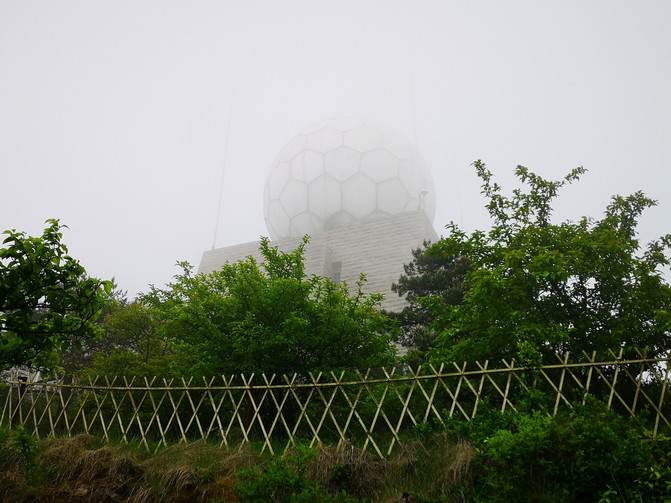
Guangmingding-Huangshan Meteorological Station

Baiyun hotel
D3
In the morning, I couldn't help but be disappointed to see that the mountains around the hotel were still shrouded in thick fog. After breakfast, I stayed in the hotel until past 9 o'clock. When I saw that the sky was shining in the distance, I decided to go to the West Sea Grand Canyon.
Starting from the hotel, you can take the Internet celebrity's small train directly to the bottom of the Grand Canyon, or you can walk from Guangmingding to the bottom of the Grand Canyon via the Flying Stone and the Paiyun Pavilion. We chose to walk to the Grand Canyon so we could see more scenery.
There is still white fog on the top of Guangmingding. The road from Guangmingding to Feilai Stone passes through a viewing platform called Qunfeng Peak. The view here is wide. When the weather is good, it should be a good place to watch the sea of clouds. At this time, apart from seeing the fuzzy shadows of several pine trees growing on the rocks, nothing can be seen. Arriving at the observation deck of Feilaishi, you can only see the faint shadow of Feilaishi in the fog.

guangmingding

group peak
Huangshan Feilai Stone is located in the northwest of Guangmingding. The stone is 12 meters high, 8 meters wide, 1.5-2.5 meters thick, and weighs about 360 tons. It has a unique shape and is amazing. What is even more surprising is that such a huge stone was erected on a flat rock about 12-15 meters long and 8-10 meters wide. The contact surface between the two rocks is very small, and the upper stone seems to fly from outside, hence the name "Flying Stone". Geologists believe that the miracle of flying stones was formed during geological changes and is truly made in heaven. The stone photographed in the 87th edition of the TV series "Dream of the Red Chamber" is the flying stone.

Flying stones in the fog
After a short stop at the Flying Stone Observation Deck, we continued on our way. This is a downhill road. After passing through the Echo Wall to the Cloud Discharge Pavilion, a light appears on the distant horizon, and the fog gradually dissipates. You can clearly see the towering peaks, winding ravines and dense pine trees.
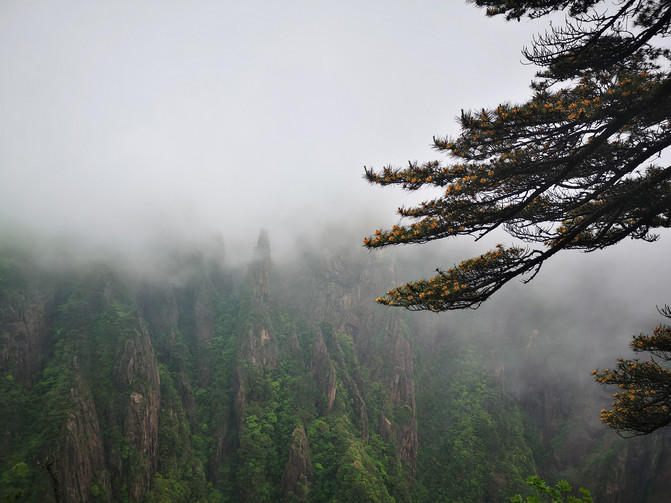
Paiyunting

Paiyunting

Paiyunting
After passing through the Cloud Pai Pavilion, you will reach the entrance of the West Sea Grand Canyon.
The Xihai Grand Canyon, located in the west of Huangshan Scenic Area, is famous for its charm. It combines tranquility and danger. It not only has the majestic momentum of thousands of towering walls and towering ravines, but also has the artistic and poetic feeling of beautiful peaks and beautiful stones like forests. It is the most beautiful and profound part of Huangshan Scenic Area. It is the most representative and stimulating, the most attractive and shocking, and can best showcase the magical craftsmanship of nature and the magnificent scenic spot of the motherland's mountains and rivers.
It takes more than 2 hours to get from the Cloud Paiying Pavilion to the bottom of the valley, and it is all down stone steps. Entering the Grand Canyon, you will see many clever stones, mysterious deep ravines, and mountain-like peaks. Giant stone slices are piled up like building blocks to form broken peaks located in the deep valley. There is no scenery, no scenery is not strange, and the scenery changes with each step, making people dizzying.

xihai Grand Canyon

xihai Grand Canyon

xihai Grand Canyon

xihai Grand Canyon

xihai Grand Canyon

xihai Grand Canyon
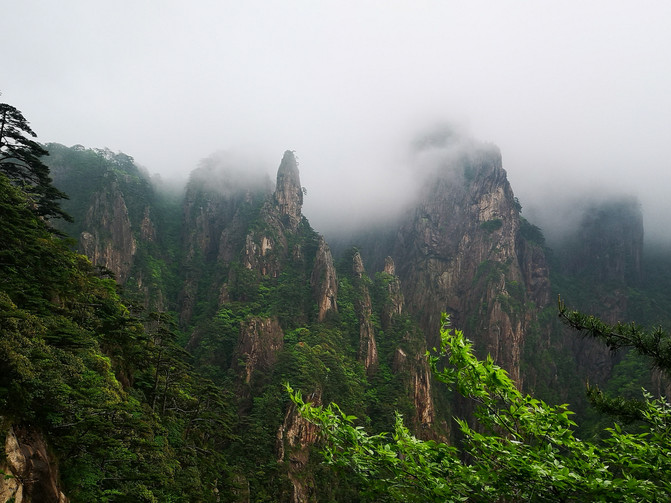
xihai Grand Canyon

xihai Grand Canyon

xihai Grand Canyon

xihai Grand Canyon

xihai Grand Canyon

xihai Grand Canyon

xihai Grand Canyon
The young man at the front desk of Tangkou Town Hotel where we stayed yesterday advised us to visit Buxian Bridge when the weather was good after going up the mountain. It was already past 2 o'clock in the afternoon when I took a small train from the West Sea Grand Canyon back to Baiyun Hotel. After resting in the hotel for a while, I decided to take advantage of the fine weather to visit Buxian Bridge.
There is a path leading to Buxian Bridge next to Baiyun Hotel. After walking along the path for more than 20 minutes, we reach the Xihai Yaotai Observation Deck, where you can view the entire Xihai Grand Canyon. There is a small iron gate next to the observation deck. It takes an hour to go back and forth from here to the Buxian Bridge. It takes 3 hours to walk through the Buxian Bridge to the bottom of the Xihai Grand Canyon. This small iron gate will close at 5 o'clock. It was almost 4 o'clock when we arrived here. The staff on duty checked in after confirming that we had booked a hotel on the mountain and returned only to Buxian Bridge. Then they let us through the small iron gate and told us to be sure to return on time. Except for tourists living in the mountains, ordinary tour groups don't come here, so there are not many people on this road. They only met a few young people walking up from the bottom of the West Sea Grand Canyon along the way. After more than 40 minutes of stopping and walking along the way, we arrived at Buxian Bridge.
Huangshan Buxian Bridge was built in 1988. A small arch bridge hangs between two cliffs. Under the bridge is an abyss, which is very steep and interesting.

Xihai Yaotai Observation Platform

Xihai Yaotai Observation Platform

Buxian Bridge

Buxian Bridge

Buxian Bridge

Buxian Bridge

Buxian Bridge
This is actually a close view of the West Sea Grand Canyon from different angles. Because the location and angles are different, the scenery you see is also different. After staying at Buxian Bridge for a while, it began to rain again, so we quickly returned the way we came.
D4
Although the rain stopped early in the morning, the mountain was still shrouded in dense fog. Until past nine o'clock, the fog still showed no signs of dispersing, and the weather forecast that there would be another thunderstorm today, so we had to prepare to go down the mountain in the dense fog. Starting from Baiyun Hotel, it takes more than ten minutes to reach Aoyufeng.
Aoyu Peak is a small mountain peak located on the way from Yuping to Beihai. It is named because the shape of the peak is very similar to that of an Ao fish. It is the first of the 36 small peaks in Huangshan Mountain. There is a triangular Aoyu Cave on the summit, with the word "Tianzao" engraved on the forehead of the cave. The cave is narrow and about 5 meters deep. There is light on the upper right and you look up at the blue sky. When you leave the cave, you will have a wide realm and a unique world. There are several stones in front of the peak, which look like snails from a distance, forming wonders such as "turtle fish eat snails" and "old turtles lay eggs". There is a tory-shaped stone on the back of the peak, called "turtle fish carrying turtle".
Aoyu Peak is a must-visit place for Huangshan Qianhou Mountains and one of the must-visit attractions for tourists. Climbing Aoyu Peak, there was only a vast expanse of white fog in front of you. This was originally a good place to see the scenery, but at this time only a few misty pine trees growing on the summit can be seen.
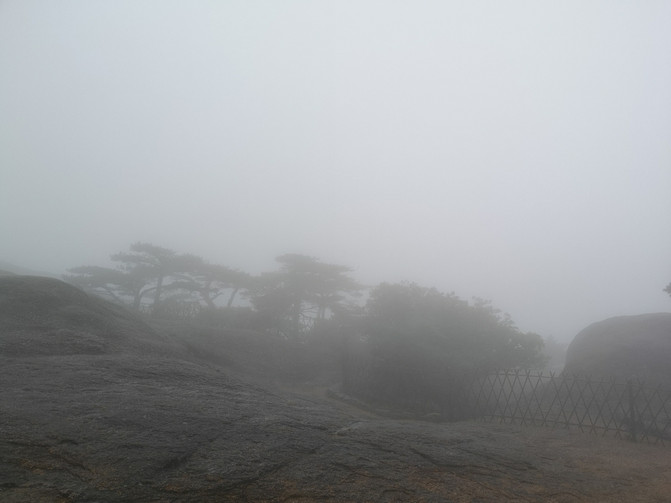
Aoyu Peak in the Mist

Aoyu Peak in the Mist
Passing through Aoyu Cave, an extremely huge whale appeared in front of us in the thick fog. The round, long and high whale body and the huge and high whale head are vivid; the whale's beak is wide open, making it seem like a whale can swallow it.
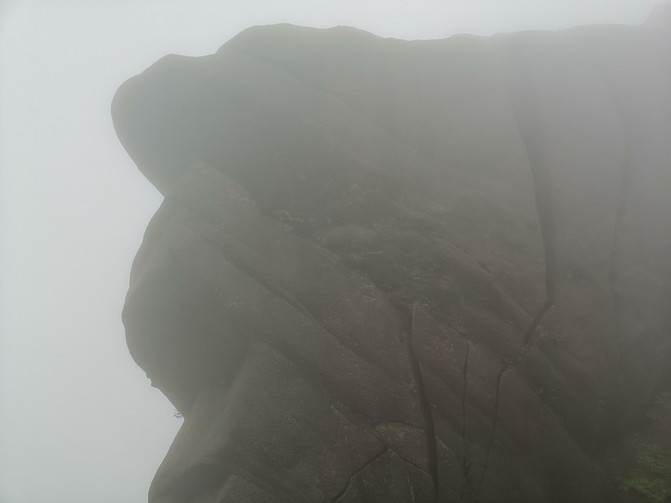
Aoyufeng

Aoyufeng
There are many people here, most of whom are tourists who came back from the Yuping Cableway up the mountain this morning and arrived at Guangmingding. After staying here for a while, we continued to reach a fork in the road, leading to Yuping Tower on the right and Lianhua Peak on the left. We chose the road to Lianhua Peak and prepared to climb the first peak of Huangshan Mountain-Lianhua Peak.
Huangshan Lotus Peak is located on the north side of Yuping Tower. It is the highest peak in Huangshan, with an altitude of 1,864.8 meters. Standing on the summit and looking into the four directions, thousands of peaks compete for beauty, and thousands of valleys produce smoke. In clear skies, you can look east to Tianmu Mountain, west to Lushan Mountain, and north to Jiuhua Mountain and Yangtze River. After the rain, looking across the sea of clouds on all sides is even more spectacular. There is also a wonder at the top of Lotus Peak, that is, all kinds of locks are hung on the iron chains around the top. It is a heart-to-heart lock for young couples or couples to join hands to show that they are united forever.
After walking through a steep mountain road, I arrived at the foot of Lianhuafeng and learned that due to weather conditions, Lianhuafeng was closed today.

Lotus peak

Lotus peak

Lotus peak

Lotus peak
After waiting here for a while, the weather still showed no signs of improving. We had to leave with regret and continue to the Yuping Tower. The iconic landscape of Huangshan Mountain-Welcome Pine is on the left side of the Yuping Tower.
Yuping Tower is the unique place where the Huangshan Collection of Wonders culminates. Behind the Yuping Tower is Yuping Peak. The famous "Yuping Reclining Buddha" is on the summit, with its head and left feet on the right, which is lifelike. The peak stone is engraved with Mao Zedong's cursive script "There are so many beauties in the mountains and rivers". This is the best place to view the Qianhai Yunhai landscape. When the weather is clear, you can also see nearby strange rocks and stones such as "Immortals Floating in the Sea","Sheep Crossing the River","Golden Turtle Watching the Moon","Squirrels Jumping into the Sky", and "Peacock Playing with Lotus". The beautiful scenery is charming and picturesque.
Huangshan Yingke Pine is located on the left side of Yuping Tower. It grows against the lion stone and breaks through the stone. It is 10 meters high, has a breast diameter of 0.64 meters, and is at least 800 years old. Two major lateral branches with a length of 7.6 meters extend out from the middle of the tree trunk and stretch forward, just like a hospitable host, waving his arms and warmly welcoming guests from afar, with a graceful attitude and a graceful attitude.
Welcome Pine is one of the must-see attractions for tourists coming to Huangshan. It was nearly noon when we arrived here. Many tourists gathered here, making it crowded. Everyone rushed to take a photo with Yingkesong. We first found a place with few people to rest for a while and eat something. Just after eating, I heard a noise from the crowd. I looked up and saw that the fog had dissipated a little, and the welcoming song was clearly displayed in front of my eyes.

yingkesong
Looking up, the stone carvings on Yuping Peak are clearly visible.

yupinglou

yupinglou

yupinglou
People were intoxicated by the scene in front of them when suddenly a mist rose from the bottom of the valley. Welcome Pine and Yuping Peak both hid back in the mist like shy girls. After a while, seeing that the fog had not yet dispersed, we decided to go down the mountain from the Yuping Cableway.
Exit the Yuping Cableway and take the scenic bus directly to Huangshan Hot Spring.
Huangshan Hot Spring has always been on par with strange pines, strange rocks, and clouds of clouds. It is called the "Four Wonders" of Huangshan. The hot spring gushed out from under Ziyun Peak and lasted all year round. The water temperature was around 42 degrees all year round. It was an alpine hot spring. The water quality mainly contains bicarbonate. The spring water is extremely clear, colorless and odorless. It tastes sweet and can be drunk and bathed. It is said that the Yellow Emperor Xuanyuan bathed here for forty-nine days to rejuvenate and ascend, so it is also known as the "Lingquan".

Huangshan Hot Spring
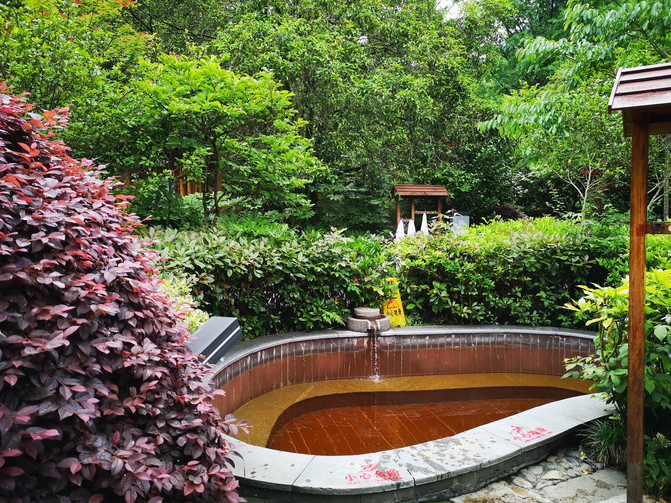
Huangshan Hot Spring

Huangshan Hot Spring

Huangshan Hot Spring
Under the embrace of hot spring water, the fatigue of climbing mountains in the past few days has been alleviated. It was not until after eight o'clock in the evening that we took a bus from the hot spring back to the hotel in Tangkou Town.
D5
It rained heavily at night. In the morning, we listened to the advice of the young man at the front desk and used the morning to visit Kowloon Waterfall. We also asked him to help book tickets and contacted the bus to Kowloon Waterfall. The round-trip fare was 60 yuan. Jiulong Waterfall is not far from Tangkou Town. After a while, the driver took us to the gate of the Jiulong Waterfall Scenic Area and left a contact number to tell us to play slowly. Call him when we came out.
Huangshan Jiulong Waterfall is located at the top of Yungu West Road. It has a total length of 600 meters and a drop of 300 meters. Each waterfall is folded in nine, and the other one is folded in a pool, forming a magnificent spectacle of nine waterfalls and nine ponds, and the waterfalls and ponds are both winning. During the rainy season, waterfalls rush on the huge cliffs and flow straight for hundreds of meters, like white silk hanging long, suspected to be the landing of the Milky Way, with an extraordinary momentum.
When you enter the scenic area, you can see a waterfall more than ten meters long pouring down. The pool water under the waterfall is as green as jade and is bright and dazzling. Looking up, you can see Tiandu Peak at the top of the canyon looming among the clouds, towering and magnificent. Along the stone road, accompanied by the sound of flowing water, the surrounding bamboo forests are lush and lush. With one waterfall and one scene, we unknowingly arrived at the ninth waterfall. I saw the waterfall hanging like a galaxy, flying beads splashing jade, extremely magnificent.

Huangshan Jiulong Waterfall

Huangshan Jiulong Waterfall

Huangshan Jiulong Waterfall

Huangshan Jiulong Waterfall

Huangshan Jiulong Waterfall

Huangshan Jiulong Waterfall

Huangshan Jiulong Waterfall
It was nearly noon after returning from Kowloon Waterfall, and we asked the front desk guy to help contact Hongcun's car. It's about an hour's drive from Tangkou Town to Hongcun. We wanted to experience the idyllic charm of Hui-style houses, so we specially booked a B & B in Hongcun Scenic Area. The owner of the B & B picked us up from the entrance of the scenic spot back to our accommodation, put down our luggage and started our tour of Hongcun.
Among the many Hui style residential villages in southern Anhui, Hongcun is the most representative. The whole village is built around mountains and water. The mountains are green because the water is green, and the water is alive because the mountains are alive. It has both the wild scenery of mountains and forests and the style of the water town. It is a unique ox-shaped ancient village in the ancient peach blossom garden. It is known as the "village in Chinese painting"."The reputation. All households in the village are connected by watercourses, and gurgling springs flow through each household. The natural landscape and humanistic connotations complement each other. This is a feature that distinguishes Hongcun from other residential buildings and has become a major miracle of the world's historical and cultural heritage today. More than 140 houses of Ming and Qing Dynasties are now well preserved in the village. The "three carvings" of Chengzhi Hall are exquisite and magnificent, and are known as the "Folk Forbidden City".
The main places to visit in Hongcun are South Lake and Yuemu, as well as a large number of well-preserved, unique, and carefully carved ancient houses of the Ming and Qing Dynasties, such as Chengzhi Hall, Shuren Hall, and Jingxiu Hall. Walking leisurely in the courtyard, the leisurely feeling is so strong that it makes people intoxicated.

Hongcun

Hongcun

Hongcun

Hongcun

Hongcun

Hongcun

Hongcun

Hongcun
Hongcun is a must-visit to Huangshan. Many tour groups come here, making the small village crowded with tourists. We followed the crowd to visit several ancient houses in the village. It suddenly began to rain. We were almost done shopping, so we returned to our place first.
The night view of Hongcun is also very beautiful. After dinner and the rain stopped, we went to the village to watch the night view. At this time, there was less noise from tourist groups in the village, and only some individual tourists were wandering around. But not long after, it began to rain again, and we hurried back to our place to rest.

Night view of Hongcun

Night view of Hongcun
D6
The sky cleared early in the morning, and the sun coated the edges of the clouds with a layer of light. Taking advantage of the quiet early morning, I came to the village again. At this time, Hongcun had just woken up. There was no longer the hustle and bustle of the day. The houses and trees on the shore were quietly reflected on the water. There were some villagers washing up on the edge of the moonmarsh. Tourists who got up early and wandered around also whispered softly. Everything seemed peaceful and peaceful.

Early morning in Hongcun

Early morning in Hongcun

Early morning in Hongcun

Early morning in Hongcun
The sun was blocked by thick clouds before it had fully risen, and the sky became gloomy again. Today we are leaving here and heading to the Huangling Scenic Area in Wuyuan. After returning to our place for breakfast, the landlady took us to Hongcun Bus Station. It takes an hour and a half by car from Hongcun to Huangshan North Railway Station, and then takes the bullet train to Wuyuan.
Wuyuan County is located in the northeastern part of Jiangxi Province, at the junction of Jiangxi, Zhejiang and Anhui provinces. It is one of the six counties in ancient Huizhou. It is known as the "Book Township" and the "Tea Township". It is a famous cultural and ecological tourism county in the country and is praised as "the most beautiful village in China" by the outside world.
Wuyuan County has many ancient villages with rich Huizhou cultural heritage and is also one of the famous rapeseed flower viewing places. We missed the season when rapeseed flowers were in full bloom, and this time we chose Huangling, which is famous for its "sunning in autumn". It is an hour's drive from Wuyuan High-speed Railway Station to Huangling Scenic Area. We booked the only hotel in Huangling Scenic Area-Wuyuan Huangling Sunset Autumn Beauty Accommodation. We checked in at the entrance of the scenic area and took the cableway up the mountain. The hotel's battery car was already waiting for us at the exit of the cableway.
Huangling is an ancient Huizhou village with a history of nearly 600 years. It has classic Hui-style buildings and typical mountain villages. The houses are arranged in a fan-shaped ladder shape around the water entrance. Now all the original villagers in Huangling have moved out, and the scenic area has been re-planned. Tianjie is like a jade belt connecting well-preserved classic ancient buildings. There are many emirary-style shops with shops in front and back, just like a flowing abbreviated version of "Qingming Festival Shanghe Map".
The hotel's rooms are scattered in different locations in the scenic area, and the warm hotel housekeeper brought us to the rooms. The room we booked was at the end of Sky Street. After settling in, we arrived at Sky Street. It was afternoon and there were many tourists on the street. After having lunch on Tianjie Street, we walked through the north entrance with the "Tianjie" archway and came to the Leixin Bridge. Leixin Bridge is also known as the Glass Bridge or High-altitude Plank Road. This is the place where Guan Guan and Xie Tong come to travel in the TV series "Ode to Joy 2".
The Lixin Bridge is between two mountains. The deck is made of wooden boards and a section in the middle is made of glass. Standing on the bridge, you can have a bird 's-eye view of the terraces on the two mountains and Xiaobian Village located in the mountain recess. At the bottom of the valley below the center surrounded by terraces, there is also a pond, which locals call "the dimple of Huangling". If it is the rapeseed season, this is a great place to appreciate the sea of terraces.

huangling

huangling

huangling

huangling
Most tourists who traveled with groups turned back when they reached the Leixin Bridge. We saw a path opposite the Leixin Bridge and a bridge below. After asking the scenic area staff and learning that we could come back from below, we decided to go around from below.
After crossing the Leixin Bridge, there is a viewing platform not far away. Standing on the observation deck, you can see the Huangling Ancient Village opposite it lying quietly on the steep slope of the mountainside, with white walls and black tiles and uneven patterns. Continue along the path, accompanied by wild flowers and insect chirping along the way, look at the green fields, breathe the fresh and humid air, and enjoy this pleasant tranquility in the embrace of nature. After stopping and walking, after a downward step, we reached the bridge we saw on the Leixin Bridge, which turned out to be Woyun Bridge.

huangling

huangling
After walking through Woyun Bridge, stayed for a while at the observation deck not far away, and returned to Tianjie.

huangling

huangling

huangling
Up the stone steps is the ancient village of Huangling.
Huangling is a well-preserved Hui-style ancient village pattern, with original ancient village style and folk customs. A large area of ancient Huizhou buildings hangs steadily and obliquely against the slope, high and low, embracing each other. The entire ancient village is as quiet and beautiful as a fairyland surrounded by flowers and green trees. During the annual harvest season, the houses become a world of drying mats. Colorful crops and black roofs overlap each other, which is very spectacular.
Now in order to develop tourism, as long as the weather is clear, you can see "sunning autumn" all year round in the scenic area. Unfortunately, the sky was gloomy when we came, and the light rain stopped sometimes, so we couldn't see the grand occasion of "sunbathing in autumn".

huangling

huangling

huangling

huangling

huangling

huangling

huangling

huangling

huangling
After visiting the ancient villages, follow the stone steps down to Huangling Huaxi Water Street.
The terrain on Huaxi Water Street in Huangling is rugged and has a large drop. The narrow water current impacts the stones in the waterway all the way, almost in a straight line. Several small-scale waterfalls are formed in the drop. The buildings on both sides of Water Street belong to the traditional Hui-style architectural style, ranging from regular masonry buildings to slightly simple earthen buildings, with diverse architectural styles. The gray walls and blue tiles, the eaves are angled, and the horse-head walls are staggered; the brick carving on the wall is exquisite and lifelike. "Green brick and small tile horse-head walls, and latticed windows hung on corridors" are the true portrayal of the building of Huangling Water Street.

Huaxishui Street

Huaxishui Street
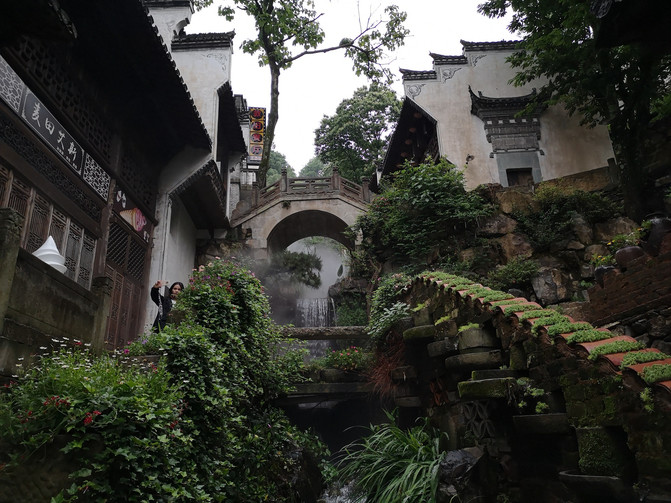
Huaxishui Street

Huaxishui Street
At the end of Huaxishui Street is a yew forest, and there are many fork roads along the path that lead to Tianjie. We walked up a fork in the road and found ourselves next to the hotel. Most places have been visited, so we can go back to the hotel to rest first.
I heard that the night view of Huangling is beautiful. After dinner, we came to the village again to enjoy the night view of Huangling.
The night in Huangling also has a unique flavor. Walking on the bluestone path, you can see beautiful light shows everywhere. In the dense forest, you feel like you are in a world of stars. The dots of light are like countless fireflies, which is pleasing to the eye.

Night view of Huangling

Night view of Huangling

Night view of Huangling

Night view of Huangling
At night, Huangling is less noisy than tourists, and the ancient village returns to tranquility. It began to rain drizzle again, and we hurried back to the hotel.
D7
Huangling did not have a large number of tourists arriving in the morning, and the ancient village became more and more peaceful. After breakfast, I went to the village again. The terraces on the hillside of Yuanwang are shrouded in the early morning fog, contrasting with the black tiles and white walls of the Hui style houses, outlining a picturesque and beautiful pastoral picture. Being in it is like a fairyland.

Huangling in the morning

Huangling in the morning

Huangling in the morning

Huangling in the morning

Huangling in the morning

Huangling in the morning

Huangling in the morning
After ten o'clock, more and more tourists gradually increased. We left Huangling for the next destination-Sanqing Mountain.
From Wuyuan to Sanqingshan, you need to take the high-speed train to Shangrao, and then change to Shuangxi Cableway Station outside Sanqingshan. After taking the cableway down the mountain, there was a bus bound for Wuyuan High-speed Railway Station preparing to depart and arrived at the High-speed Railway Station around 12 o'clock. We booked a train ticket from Wuyuan to Shangrao at more than 3 o'clock online in advance, but after arriving at the high-speed railway station, we could no longer change the ticket to an earlier point. It was nearly 4 o'clock when we arrived at Shangrao Station. Arriving at Shangrao East Bus Station on the right hand side of the railway station exit, I learned that there are no more trains to Shuangxi Cableway Station outside Sanqing Mountain today. We have to stay in Shangrao tonight and go to Sanqing Mountain early tomorrow morning.
D8
The place where I stayed yesterday was very close to the station. In the morning, I checked my luggage at the hotel and took the bus to Sanqing Mountain. It took about an hour and a half to drive from Shangrao East Bus Station to Waishuangxi Cableway Station. We asked the driver about the return time of the car and started our journey to Sanqing Mountain.
Sanqing Mountain, also known as Shaohua Mountain and Yashan Mountain, is located at the junction of Yushan County and Dexing City in Shangrao City, Jiangxi Province. It is named because the three peaks of Yujing, Yuxu and Yuhua are like Taoist Yuqing, Shangqing and Taiqing, which sit on the top of the mountain. The scenic area has thousands of beautiful peaks and lush ancient trees. It is surrounded by clouds and fog all year round, full of fairy charm. Unique granite stone pillars and mountain peaks, lifelike granite shaped stones combined with rich ecological vegetation and climate wonders that change far and near, create a unique landscape in the world, present fascinating natural beauty, and is known as "the most beautiful mountain in the world". At the same time, it is also a famous Taoist mountain that has experienced thousands of years of humanistic infiltration. Taoism has a long history. It is said that Ge Hong in the Eastern Jin Dynasty "formed a Lu and refined alchemy" on the mountain. The Sanqingshan Taoist ancient buildings are exquisitely laid out in accordance with the "Eight Trigrams", hidden cleverness and magnificent momentum. It is a unique model for studying the design and layout of ancient Taoist buildings in my country, and is known as the "open-air museum of ancient Chinese Taoist architecture."
As soon as we stepped out of the cableway and started going up the mountain, it started to rain. Fortunately, we had booked Rishang Villa not far from the cableway station, and we hurried up the mountain. It took about 20 minutes to climb the steps to Rishang Villa. At this time, the rain was getting heavier and heavier. We checked in first and went to our room to rest.
The tour route of Sanqing Mountain is two rings in the shape of an "8". Rishang Villa is located at the intersection of the two rings. It is a hotel with a better location on Sanqing Mountain. At around 10 o'clock, the rain gradually stopped. Today, we are going to visit one of the ring roads first, the West Coast Scenic Area, Sanqing Fudi Scenic Area and the Sunshine Coast Scenic Area.
After coming out of the hotel, the sky was gloomy, and many tourists who had just climbed the mountain gathered on the platform outside the hotel. From the hotel to the West Coast Scenic Area, you need to go up a few steps first, and then a 4-kilometer-long high-altitude plank road.
The West Coast, also known as the West Sea Plank Road, is the longest floating plank road, the flattest road and the widest view in Sanqing Mountain and even in the world. The viewing corridor is the most shocking and dangerous scenic spot in Sanqing Mountain.
When the weather is fine, walking on the high-altitude plank road in the Grand Canyon and overlooking the beautiful scenery of the mountains gives you a feeling of relaxed and relaxed feeling. To the east are endless cliffs as the shore, to the west are deep and unpredictable canyons as the sea, and in the distance are continuous mountains and fog sea. There are many strange peaks and rugged rocks, and the exquisite craftsmanship is like nature; the rich and diverse plants make the canyon look more lush, giving people the wonderful feeling of "wandering freely in the West Sea, happy like a fairy".
Now the mountain is full of fog, and we can only vaguely see some nearby scenery. Fortunately, there are blooming azaleas beside the plank road to enjoy.

West Coast Scenic Area
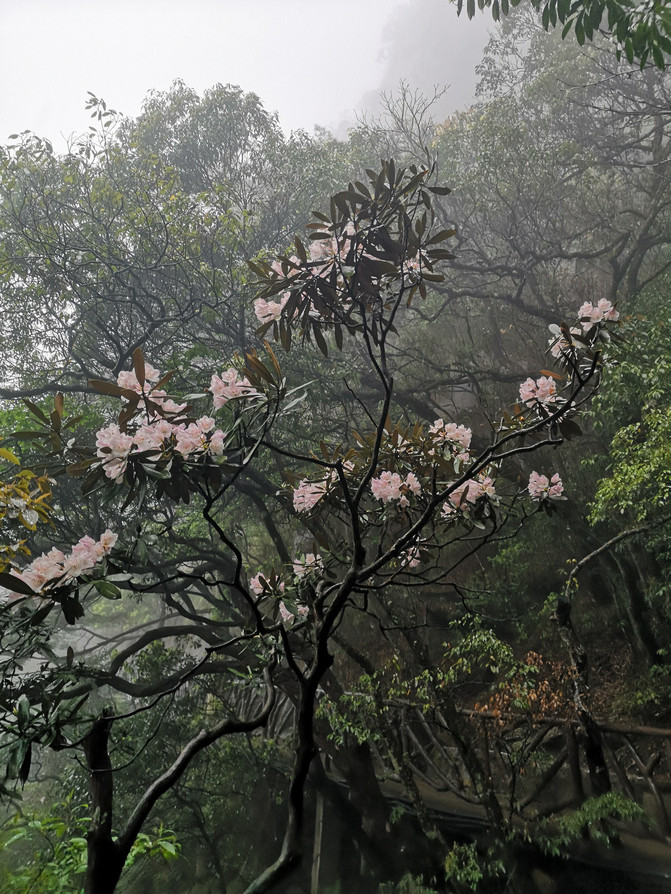
West Coast Scenic Area

West Coast Scenic Area

West Coast Scenic Area

West Coast Scenic Area
Yusonglin Service Area is the end of the West Coast Plank Road. From here, you will find the Sunshine Coast Scenic Area. There is a fork road next to it that leads to the Sanqing Fudi Scenic Area. There are many tourists resting here, and we walked towards the Sanqing Fudi Scenic Area without hesitation.
The Sanqing Fudi Scenic Area carries the profound Taoist culture of Sanqing Mountain. The Taoist buildings follow the mountains and rivers and follow the directions of the Eight Trigrams, integrating the natural landscape with Taoist concepts and with the natural scenery of Sanqing Mountain.
Not many people came to Sanqing Fudi Scenic Area, and we didn't meet many people along the way. There were many squirrels and other small animals with us. It began to rain again when it was approaching Sanqing Palace, and all the surrounding scenery was shrouded in fog.
Sanqing Palace is a landmark building of Sanqing Mountain Taoism, a rich place for Sanqing Mountain's profound cultural landscape, and an "open-air museum" of Sanqing Mountain's ancient Taoist buildings.

Sanqing Fudi Scenic Area

Sanqing Fudi Scenic Area

Sanqing Fudi Scenic Area
Coming out of the Sanqing Palace and continuing along the stone steps is the Sunshine Coast Scenic Area.
The Sunshine Coast Scenic Area, also known as the East Coast, has a total length of 3600 meters. It is the best place to enjoy the magnificent scenery of the eastern part of Sanqing Mountain. Walking on the Sunshine Coast on a sunny day, walking on floating clouds and wearing fog gauze is like wandering among fairyland. Looking around, you can have a panoramic view of magnificent landscapes such as mountains and stone forests in the distance.
Walking on the plank road, the mountains in the distance are shrouded in clouds and looming. The rain is getting heavier and heavier, the fog is getting thicker and thicker, and the surrounding scenery is slowly wrapped up in the fog.

Yangguang Coast Scenic Area

Yangguang Coast Scenic Area

Yangguang Coast Scenic Area
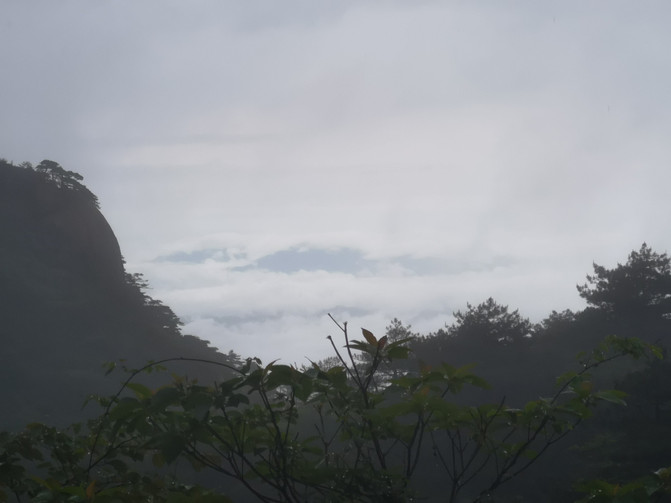
Yangguang Coast Scenic Area

Yangguang Coast Scenic Area
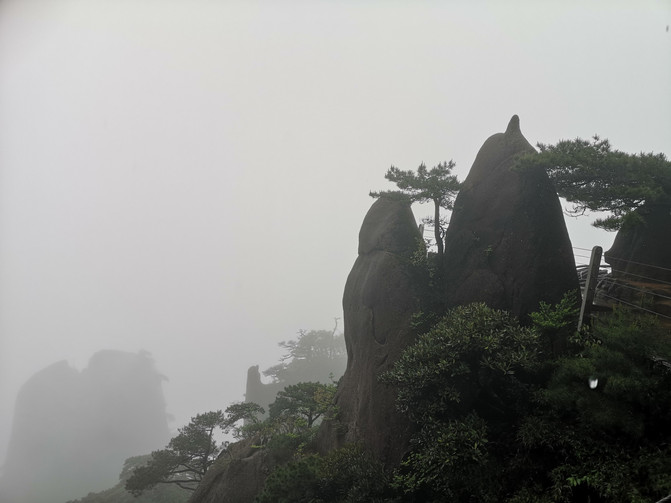
Yangguang Coast Scenic Area

Yangguang Coast Scenic Area
After more than 5 hours of walking, we returned to Rishang Villa.
D9
It rained all night, and in the morning it cleared up and a sea of clouds appeared.

Rishang Platform

Rishang Platform

Rishang Platform

Rishang Platform

Rishang Platform

Rishang Platform
After seeing the sea of clouds on the platform in front of the hotel, I quickly went back to my room to pack my things and headed to Nanqing Garden Scenic Area, another ring road on Sanqing Mountain. Starting from Rishang Villa, you can go up the steep slope from Yixian Tiantian via Yutai to Nanqing Garden, or you can go around the relatively easy southeast plank road, but the journey is relatively long. We chose to detour from the southeast plank road.
The southeast plank road is a reinforced and mixed soil plank road that overhangs outwardly and is 1.3 meters to 2 meters wide, with a total length of about 3700 meters. Walking along the plank road hanging on the cliffs, looking into the distance, the mountain breeze blows, the clouds disappear, the mountain peaks are revealed, the mountains are undulating, and the green mountains are like white. The unpredictable scenery gives us a wonderful feeling like a fairyland.

Southeast Plank Road

Southeast Plank Road
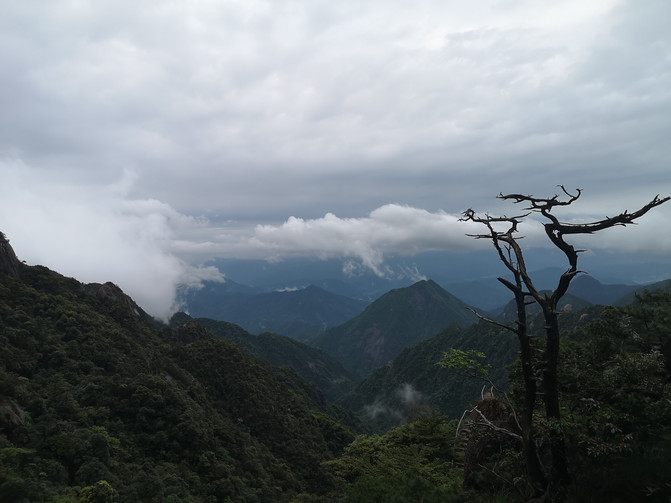
Southeast Plank Road
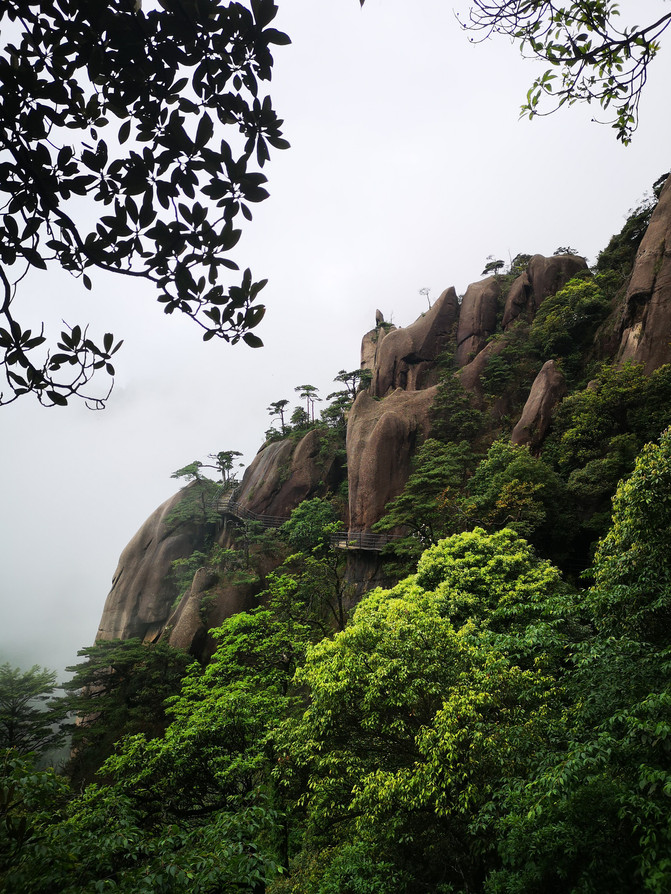
Southeast Plank Road

Southeast Plank Road

Southeast Plank Road

Southeast Plank Road

Southeast Plank Road

Southeast Plank Road
You can also overlook the Wanshou Garden Scenic Area from the southeast plank road.
Wanshou Garden Scenic Area is located at the southern foot of Sanqing Mountain. It is a scenic spot with the theme of Xiangshou Culture. The strange peaks and rocks in the scenic area are naturally mixed, and the beautiful colors of the Xianfeng contain traditional Chinese longevity culture and Taoist ways of self-cultivation. The entire scenic area is like a natural bonsai.

Wanshou Park Scenic Area
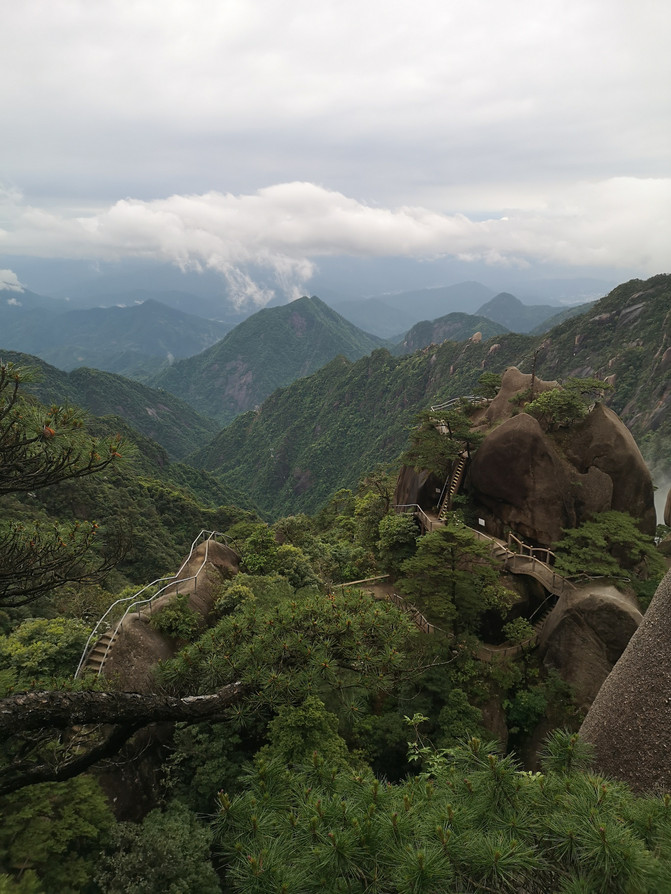
Wanshou Park Scenic Area

Wanshou Park Scenic Area
In the morning, there were only the two of us on the plank road. We were attracted by the beautiful scenery in front of us all the way. We stopped and walked. After walking on the plank road for more than an hour, we heard the noise in front of us. It turned out that the Nanqing Garden Scenic Area was in front of us.
Nanqing Garden is one of the most amazing scenic spots in Sanqing Mountain, with an altitude of 1557 meters. The most impressive ones in the scenic area are several iconic mountain peaks of Sanqing Mountain, such as Python Mountain, Goddess Sichun, etc., all in form and spirit.
Nanqing Garden is a must-visit attraction to Sanqing Mountain. There are many tourists here who have just climbed the mountain from the Jinsha Cableway. Everyone gathers in front of the two landscapes of the goddess Sichun and the giant python coming out of the mountain to take photos. The goddess and the python seemed to be playing hide-and-seek with tourists. For a while, they hid behind thick clouds. After a gust of mountain wind, they were clearly displayed in front of people.

Goddess Si Chun

Python comes out of the mountain
After seeing the goddess Si Chun and the python come out of the mountain, we went down the steep steps of Yixian Tian from Nanqing Garden through Yutai. It was already past 11 o'clock when we returned to Rishang Villa. After checking out, we took the cableway down the mountain.

Nanqing Park Scenic Area

Nanqing Park Scenic Area

Nanqing Park Scenic Area

Nanqing Park Scenic Area

Nanqing Park Scenic Area

Nanqing Park Scenic Area

Nanqing Park Scenic Area

Nanqing Park Scenic Area

Nanqing Park Scenic Area
Yesterday, I asked the bus driver that there was a bus back to Shangrao at 12 o'clock. When I went back to the place where I got off yesterday, I learned that the bus back to Shangrao would leave at 12:45. Fortunately, our train to Jingdezhen was after 3 o'clock in the afternoon, so there was still plenty of time.
We went back to the hotel to pick up our luggage and asked the hotel owner to roast two Shangrao chicken legs for us. After we had eaten, we arrived at the railway station and just in time for the train to Jingdezhen.
D10
Jingdezhen is a famous porcelain capital and has accumulated a profound ceramic culture. Today, we must first go to the Jingdezhen Ancient Kiln Folk Customs Expo Area to learn about Jingdezhen's ceramic culture.
Jingdezhen Ancient Kiln Folk Customs Expo Area is located in Panlonggang, Fengshu Mountain, Changjiang District, Jingdezhen City, Jiangxi Province. It covers an area of 83 hectares. It is a cultural tourist attraction integrating cultural exhibitions, ceramic experience, entertainment and leisure. It is the only national-level tourist attraction in the country with the theme of ceramic culture.
There are many buses from People's Square near my residence to the Ancient Kiln Folk Culture Expo Area. After getting off the bus, I walked through a quiet ancient porcelain visiting road and entered the scenic spot, and began to have a close contact with Jingdezhen's ceramic culture.
The Ancient Kiln Folk Customs Expo Area has the oldest porcelain production line in the world, as well as porcelain kilns from the Song, Yuan, Ming and Qing Dynasties, Fenghuo Xianshi Temple, the handmade porcelain making process in Jingdezhen during the Ming and Qing Dynasties, and traditional famous porcelain works, you can understand the ancient culture of ceramics from many aspects.
The most interesting thing is the ancient kiln display area of the past dynasties. Not only can you see ancient porcelain kilns of different shapes, but there are also many veteran artists in the porcelain workshop to show you traditional handmade porcelain craftsmanship.

Jingdezhen Ancient Kiln Folk Customs Expo Area--Visiting the Ancient Porcelain Road

Jingdezhen Ancient Kiln Folk Customs Expo Area

Jingdezhen Ancient Kiln Folk Customs Expo Area

Jingdezhen Ancient Kiln Folk Customs Expo Area

Jingdezhen Ancient Kiln Folk Customs Expo Area
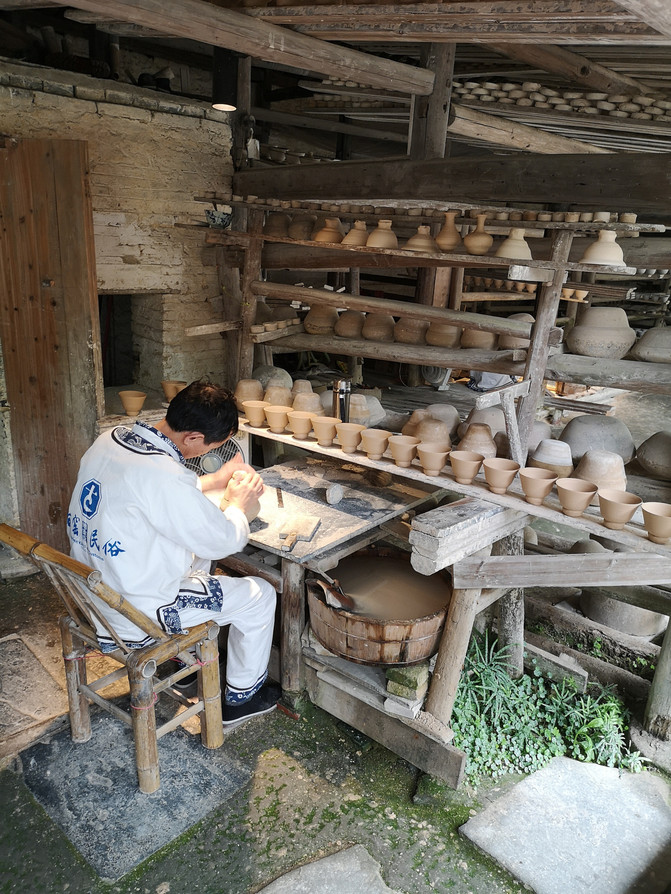
Jingdezhen Ancient Kiln Folk Customs Expo Area--Porcelain Making Workshop

Jingdezhen Ancient Kiln Folk Customs Expo Area--Porcelain Making Workshop

Jingdezhen Ancient Kiln Folk Customs Expo Area--Porcelain Making Workshop

Jingdezhen Ancient Kiln Folk Customs Expo Area--Porcelain Making Workshop
Dragon Kiln is one of the traditional Chinese ceramic kilns. The kiln is built tilted according to the mountains and is named after its shape like a dragon. The dragon kiln has a simple structure and is divided into three parts: kiln head, kiln bed and kiln tail. Generally use thatch, branches, etc. as fuel. Low cost, large charging and burning capacity, and can make full use of waste heat. Using natural hillsides to build, the flame draws great force, which can form a reducing atmosphere for firing celadon and shadow celadon. Long Kiln made outstanding contributions to the prosperity of Jingdezhen's porcelain industry in the Song Dynasty.

Jingdezhen Ancient Kiln Folk Customs Expo Area-Song Dynasty Dragon Kiln

Jingdezhen Ancient Kiln Folk Customs Expo Area-Song Dynasty Dragon Kiln
The steamed bun kiln is one of the typical porcelain kilns used in Jingdezhen during the Song, Yuan and Ming Dynasties. It is named after the kiln's shape is similar to steamed buns. The plane of the kiln bed of some steamed bun kilns is horseshoe shaped, so it is also called horseshoe kilns. The firing temperature can be as high as 1,300 degrees, and a reducing atmosphere can be formed. Through continuous exploration by Jingdezhen kiln workers, the construction skills and firing skills of Yuanming steamed bun kiln have reached the highest level of such kilns in my country's traditional porcelain industry.

Jingdezhen Ancient Kiln Folk Customs Expo Area--Yuan Dynasty Steamed Bun Kiln

Jingdezhen Ancient Kiln Folk Customs Expo Area--Yuan Dynasty Steamed Bun Kiln
The gourd kiln is the abbreviation for Jingdezhen gourd shaped firewood burning porcelain kiln. It is a unique porcelain kiln in Jingdezhen. It first appeared in the late Yuan and early Ming Dynasties, and was gradually stopped in use until the egg-shaped kiln (Zhen kiln) appeared in the early Qing Dynasty. The gourd kiln in the Ming Dynasty combined the advantages of the dragon kiln and the steamed bun kiln in the Song and Yuan Dynasties, and made great progress in its firing skills, making outstanding contributions to the development of Jingdezhen porcelain industry in the entire Ming Dynasty and the formation of Zhen kilns in the Qing Dynasty.

Jingdezhen Ancient Kiln Folk Customs Expo Area--Ming Dynasty gourd kiln

Jingdezhen Ancient Kiln Folk Customs Expo Area--Ming Dynasty gourd kiln
Zhen Kiln in the Qing Dynasty (referred to as "Zhen Kiln") is a unique porcelain kiln among traditional kilns in my country. The kiln house is a wooden frame building with a total length of 15-20 meters and a volume of about 300 cubic meters, with a highest point of about 6 meters. Using pine firewood as fuel (hence it is also called "firewood kiln"), the flame is long and has little ash, does not contain harmful objects, and is suitable for burning reducing flames. It has a good coloring effect on glaze of white porcelain, blue and white porcelain, color glaze, etc. Zhen Kiln is the most completely preserved and valuable ancient kiln so far.

Jingdezhen Ancient Kiln Folk Customs Expo Area-Qing Dynasty Zhenyao

Jingdezhen Ancient Kiln Folk Customs Expo Area-Qing Dynasty Zhenyao

Jingdezhen Ancient Kiln Folk Customs Expo Area

Jingdezhen Ancient Kiln Folk Customs Expo Area
After visiting the Ancient Kiln Folk Customs Expo Area, take a taxi at the entrance of the scenic area to the fifth county government office in Fuliang County-Fuliang Gu County.
The Fuliang Gu County Yamen was built during the Daoguang Period of the Qing Dynasty, 170 years ago. It is the only completely preserved county-level government office in the south of my country in the feudal era. It is also one of the few remaining ancient county government offices in the country. It is known as "China's No. 1 County Government" and "Jiangnan's No. 1 Government". The architecture of the ancient county government has the characteristics of combining the Hui and Gan schools. The whole building faces north to south, with a grand scale and well-organized layout. The corridors are connected to each other, making it a seamless one. It is solemn and relaxed, and it is heavy and beautiful. The Zhaobi, Toumen, Yamen, Yamen, lobby, Second Hall and Third Hall on the central axis are now preserved, basically maintaining the original style of the county government. In the 33rd year of Qianlong of the Qing Dynasty, Fuliang Zhengtang was awarded a five-level addition, making it the highest-grade county government in China. Traveling through the ancient county government, you can appreciate the "wonderful" architectural art, appreciate the style of the ancient government, and feel the majestic style of the feudal government. At the same time, you can also understand the historical, political and cultural knowledge of the feudal government.

Fuliang Gu County Ya

Fuliang Gu County Ya

Fuliang Gu County Ya

Fuliang Gu County Ya

Fuliang Gu County Ya

Fuliang Gu County Ya
It was still early to return to the city from Fuliang Gu County Government, so I decided to visit the Imperial Kiln Factory not far from my residence.
In the early Ming Dynasty, an imperial kiln factory was established in Jingdezhen to manufacture porcelain for the emperor and imperial porcelain awarded by the emperor to officials for the inner courtyard of the palace. Palace porcelain began to indicate the emperor's year of year. Due to the privilege of the Imperial Kiln Factory, it has always gathered Jingdezhen's pottery elites and skilled craftsmen. Although it is specially designed to burn porcelain for emperors, objectively it has created a large number of rare treasures of porcelain culture for the Chinese nation and is the cradle of pottery treasures. In addition to many lost overseas, there are still many rare pottery objects that are collected by the Palace Museum and displayed to tourists at home and abroad.
Longzhu Pavilion is located on the Zhushan official kiln site in Jingdezhen. It has been a representative building of the Imperial Kiln Factory since the Ming Dynasty. It is the official kiln site in the Ming and Qing Dynasties. Therefore, it has become the symbol of Jingdezhen porcelain and has now become the city emblem of Jingdezhen. Countless precious cultural relics are buried underground around the Longzhu Pavilion, leaving a large number of precious cultural relics from the Ming and Qing Dynasties. The exhibits exhibited by the Longzhu Pavilion Official Kiln Porcelain Museum in Jingdezhen over the years are representative masterpieces selected from them.

Royal kiln factory

Royal kiln factory

Royal kiln factory

Royal kiln factory
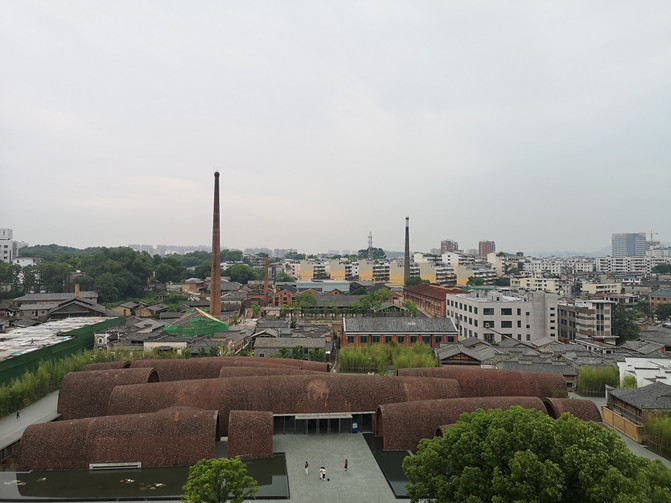
Royal kiln factory
D11
Yaoli was named "Yaoli" in ancient times, named because Jingdezhen was the birthplace of ceramics. As far back as the middle of the Tang Dynasty, there were handicraft workshops producing ceramics here. It was not until the beginning of this century that the porcelain kiln moved out, and "Yaoli" was renamed Yaoli.
Yaoli Scenic Area integrates natural scenery such as mountains, forests, waterfalls, canyons, etc. with cultural landscapes such as ancient towns and ancient kiln sites. The mountains, rivers and humanities are beautiful, primitive, simple and quiet, and the climate is suitable all year round. It is a place to enjoy the baptism of nature. Green home is a good place to visit the ancient world and experience the unity of nature. It is known as the "source of porcelain, the hometown of tea, and the sea of forest". Yaoli Scenic Area includes 5 sub-scenic spots, from northeast to southwest: Wanghu Ecological Tourist Area, Meiling Leisure Resort, Raonan Ceramic Theme Park, Porcelain Tea Ancient Town Tourist Area, and Kaolin Mine Heritage Park.
Yaoli is 50 kilometers away from the urban area of Jingdezhen. There are not many cars from the urban area to Yaoli, and the scenic spots are relatively scattered. There is a distance of more than ten kilometers between the ancient town of Cicha and Wanghu, and there is no shuttle bus. In order to facilitate travel, we booked a one-day trip to Yaoli today. The departure time was agreed with the driver last night, and the driver arrived at the hotel on time early in the morning.
After about an hour's drive, the first thing to arrive at is the Luonan Ceramic Theme Park.
The Raonan Ceramic Theme Park reflects the long and splendid ceramic culture in the East River Basin of Jingdezhen. It preserves many ancient kiln sites from the Song, Yuan, Ming and other periods, as well as a large number of porcelain relics such as ancient mine caves and ancient water pestle. It is of great value to study the production status of ancient Jingdezhen porcelain industry. Among them, the Raonan Deposit is the most representative site with the characteristics of ceramic production sections found in the world. Raonan Ceramic Garden also fired glazed tiles for the imperial palace of Zhu Yuanzhang, the founder of the Ming Dynasty. It was the earliest architectural porcelain produced in Jingdezhen.

Raonan Ceramic Theme Park

Raonan Ceramic Theme Park

Raonan Ceramic Theme Park

Raonan Ceramic Theme Park

Raonan Ceramic Theme Park

Raonan Ceramic Theme Park
The Baonan Ceramic Theme Park is not big, and you can visit it all in almost an hour. After driving for more than ten minutes, we arrived at the most beautiful Wanghu Ecological Tourist Area in Yaoli.
The Wanghu Ecological Tourism Area has steep mountains and dense forests, and the scenery is magnificent. There are not only flowing springs, waterfalls, strange stone caves, but also thousand-year-old camphor groups and virgin forests. It integrates mountains, water, rocks and forests, gathering dangers, oddity, and beauty. It combines the scenery of the four seasons and changes into a moment. It is a good tourist destination for exploring the scenery.
The Nanshan Waterfall Group located in Wanghu Ecological Tourism Area consists of four waterfalls: Nanshan Waterfall, Shihua Waterfall, Feilong Waterfall, and Piaojin Waterfall. The waterfall group has a total length of more than 400 meters, with a drop of 220 meters, and the main waterfall is 70 meters wide. One water and four waterfalls meet end to end, from large to small, first rapid and then slow, if broken or continuous, sometimes fading. The scenery of the four waterfalls is different.

Wanghu Ecological Tourism Area

Wanghu Ecological Tourism Area

Wanghu Ecological Tourism Area

Wanghu Ecological Tourism Area

Wanghu Ecological Tourism Area

Wanghu Ecological Tourism Area

Wanghu Ecological Tourism Area

Wanghu Ecological Tourism Area

Wanghu Ecological Tourism Area

Wanghu Ecological Tourism Area

Wanghu Ecological Tourism Area
After having lunch at the Wanghu Ecological Tourism Area, we returned to Yaoli Ancient Town.
Yaoli Ancient Town is one of the first batch of famous historical and cultural towns in Jiangxi Province and has a history of more than two thousand years. A winding and clear Yao River runs through the east and west of the ancient town. Hundreds of ancient buildings in the Ming and Qing Dynasties are scattered along the river, with flying eaves and rising corners, white walls and black tiles, hidden among the green mountains and clear waters. Strolling through the streets paved with bluestone in the ancient town will make you feel like you have walked into the historical picture of Ming and Qing society.

Yaoli Ancient Town

Yaoli Ancient Town

Yaoli Ancient Town

Yaoli Ancient Town

Yaoli Ancient Town

Yaoli Ancient Town

Yaoli Ancient Town

Yaoli Ancient Town
On the way back to Jingdezhen, I heard the driver say that every Saturday night, the night market in Taoxichuan Creative Plaza is very lively. Today is Saturday, and we decided to go to Taoxichuan Creative Plaza in the evening.
Taoxichuan Creative Plaza is located in Dongcheng Area, Jingdezhen City. It is a new type of literary and artistic district with the theme of ceramics. It is a fusion of history and modernity, a crossing between tradition and fashion. It is a new cultural landmark and a new city business card of Jingdezhen.
In addition to a large pottery exhibition area and some fixed shops, there will also be many small vendors setting up stalls in the night market to specialize in various pottery works. There are expensive and cheap ones, so you can slowly find what you like.

Taoxichuan Creative Plaza

Taoxichuan Creative Plaza

Taoxichuan Creative Plaza

Taoxichuan Creative Plaza
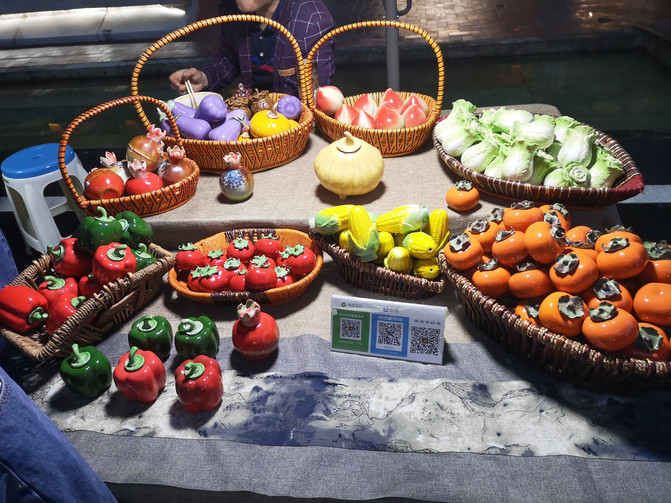
Taoxichuan Creative Plaza

Taoxichuan Creative Plaza

Taoxichuan Creative Plaza
D12
Take a train from Jingdezhen to Jiujiang Railway Station at around 8 o'clock in the morning. There is a bus not far from the exit to Jiujiang Bus Station, and then take a bus from the bus station to Lushan.
Lushan Mountain, also known as Kuang Mountain and Kuang Lu, is one of the top ten famous mountains in China. Lushan Mountain is majestic, with many cliffs and cliffs, flying waterfalls and clouds. It is famous around the world for its heroism, strangeness, danger and beauty, and is known as "Kuang Lu's Qixiu is the best in the world".
The hotel we booked is located in Guling Town on the mountainside of Lushan Mountain. We take a bus from the bus station to Guling Town. The car first stopped at the tourist center at the foot of Lushan Mountain. The driver told us to buy tickets here to enter the scenic spot, and then returned to the car and continued to Guling Town. After we got off the bus and checked in to enter the scenic spot, we got back to the car. The car drove on the winding mountain road for more than an hour to Guling Town.
Guling Town, which is surrounded by mountains on three sides and faces the valley on one side, is the center of tourism reception for Lushan Mountain. It is known as the "Mountain City in the Cloud" and is the political, economic, cultural and tourism center of Lushan Mountain with three gold-lettered signboards: the world cultural landscape, the world geological park, and the world's excellent eco-tourism scenic spot. During the day, you can lean on the railing to overlook the vast Yangtze River, Poyang Lake and the beautiful scenery of Jiujiang City. At night, you can enjoy the prosperous lights of Lushan and Jiujiang City here. It is a paradise that cultivates your temperament.
It was noon when we arrived in Guling Town, and the car stopped at the tunnel entrance not far from the bus station. It was raining heavily, so we called the hotel owner to pick us up.
The rain stopped at 3 p.m., so we decided to take a look around Guling Town first. The hotel is on Guling Street, and not far from the hotel is the street center park.
Standing in the park in the heart of the street, looking around, the deep red and green iron roofs are like bright mushrooms scattered in the green valley. They are quiet and ethereal, and cool colors and warm colors are so beautifully blended together. Together, it seems to form a fairy tale world.

Street heart Park

Street heart Park

Street heart Park

Street heart Park
Go ahead from Street Center Park through a tunnel not far away and follow the road to Meilu.
Meilu is a unique cultural landscape in Lushan Mountain, which shows a side of the ever-changing modern history of China. "Meilu" was once the summer capital official residence of Chiang Kai-shek. It was the "beautiful house" where the "First Lady" lived at that time. The historical trajectory it evolved was closely related to the events of the century. It was once a "forbidden garden", wrapped in floating clouds day and night, which is fascinating and confusing. Nowadays,"Meilu" opens up its true colors and attracts tourists from home and abroad with its unique charm and charm.

meilu

meilu
Opposite Meilu is the Zhou Enlai Memorial Room. Unfortunately, it is under maintenance and is not open to the public. Starting from the Zhou Enlai Memorial Room, old houses with iron roofs are hidden among the green trees on both sides of the road. This is the old villa area of Lushan Mountain.
The old Lushan Villa is located in Lushan Mountain in Jiujiang, Jiangxi Province, mainly concentrated in the Donggu. Since 1895 AD, British missionary Li Deli spent 200 taels of silver to lease 800 acres of land along the Changchong River in Guling to build a summer vacation, more than 20 countries including Britain, France, the United States, Germany, and Russia have built Western-style buildings here. These buildings have beautiful shapes, different styles, and rich cultural heritage. They are like holding a meeting at the United Nations. They can be called the "World Villa Architecture Art Museum". After liberation, Mao Zedong, Liu Shaoqi, Zhou Enlai, Zhu De and other national leaders also lived here. "If I don't look at the old villa in Donggu, I won't know the true face of Mount Lushan." The old villas in Lushan take you into the real life scenes of Lushan in the early 20th century, allowing you to understand the origin of the old villas in Lushan and experience the history and culture of Lushan. Each of the old villas that has gone through hundreds of vicissitudes has a story unique to it. When each story comes together, it is the story of Lushan Mountain.

Lushan Old Villa

Lushan Old Villa

Lushan Old Villa

Lushan Old Villa

Lushan Old Villa

Lushan Old Villa

Lushan Old Villa
Walking around among the old villas in Lushan on the stone steps covered with moss marks, it was already past 6 o'clock before you knew it. After returning to Guling Street for dinner, shopping around the shops on the street, I returned to the hotel to rest.

kuling Street
D13
The sightseeing bus route for Lushan is divided into east and west lines, connecting various scenic spots on Lushan. We took the sightseeing bus to Wulaofeng on the east line first.
Wulaofeng is located in the southeast of Lushan Mountain. Because the top of the mountain is cut off by a pass, it is divided into five parallel peaks. Looking up at the five old men sitting on the ground, people call the five peaks originally formed on the same mountain collectively."Wulaofeng". Observed from all angles, the mountains are different in appearance. Some are like poets chanting, some are like samurai singing, some are like fish fishing, and some are like old monks sitting cross-legged. Among the five peaks, the third peak is the most dangerous, with various strange rocks and rocks, which are magnificent and beautiful. The fourth peak is the highest, with clouds and pine trees at the top curved like a dragon. There are five small peaks below, namely Lion Peak, Jinyin Peak, Shijian Peak, Lingyun Peak and Qigan Peak. Down there are Guanyin Cliff and Lion Cliff, and the valley behind is Qinglian Temple.
Climbing the stone steps up the mountain, there is a thin layer of clouds and mist floating among the mountains, and soon you arrive at a peak.

wulaofeng

wulaofeng
The second peak is very close to the first peak, but the second peak is currently shrouded in clouds and mist.

wulaofeng
They kept going up and down along the mountain path, and when they reached the three peaks, a mountain breeze blew past. The clouds and mist were torn open by the mountain breeze, and the blue sky covered the fog.
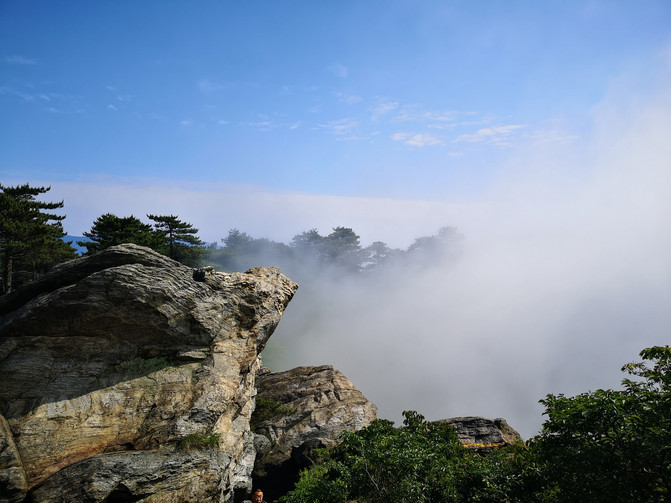
wulaofeng

wulaofeng

wulaofeng

wulaofeng

wulaofeng
Continue on and reach the fourth peak of Wulao Peak, the highest peak of Wulao Peak. It suddenly opens up in front of you, the sky is blue, and the clouds are floating in the mountains like continuous cotton wool.

wulaofeng

wulaofeng
After staying at the fourth peak for a while, he continued on to the fifth peak. There is a fork in the road as you approach Wufeng. The five peaks are up, and the other path down can reach Sanshi Spring. We continued to follow the stone steps up to the summit of the five peaks. At this time, the surroundings were wrapped in clouds and mist, and the scenery around us was looming in the dense gaps in the clouds and mist.

wulaofeng

wulaofeng

wulaofeng
After coming down from the Wufeng and returning to the fork in the road, we went down the path and reached the entrance of Triassic Spring after more than an hour.
The Lushan Waterfall Group, mainly composed of Sanshiquan Waterfall, Shimenjian Waterfall, Huanglongtan and Wulongtan Waterfall, Wangjiapo Twin Waterfall and Yulianquan Waterfall, is known as one of the ten most beautiful waterfalls in China.
Triassic Spring is also known as the third-level spring and Shuilian Spring, with a drop of 155 meters. The ancients called it "Kuanglu Waterfall, the first to be the Sandian" and praised as "the first wonder of Lushan Mountain." One stack hangs straight, and the water tilts down from the back of the top of the mountain more than 20 meters long; the second stack bends straight into the pool; to feel the visual impact of Sanshui Spring up close, you also need to go down to the bottom of the valley to see the three stacks.
There is a cable car from the entrance of the scenic area to reach Yilai. We did not take the cable car, but walked down the stone steps and paths, accompanied by a stream along the way. It took about 40 minutes to reach the Yidui service point, which is also the end of the cable car. From here, you have to pass through 1600 steps and walk down the mountain to reach the Sandui at the bottom of the valley.
Standing on the third stack, I looked up, but I saw the Triassic Spring throwing pearls and jade like thousands of pearls flying in the sky. Standing in the "Waterfall Watching Pavilion", you can overlook the three stacks. Listening to the sound of the waterfall is like beating drums, and roaring like thunder; seeing the waterfall water splashing jade and falling into the deep valley. Looking up and looking down is of its own beauty, so there is a saying that "you are not a visitor to Lushan until you reach Sanshiquan."

sandiequan

sandiequan

sandiequan

sandiequan

sandiequan

sandiequan
You can go directly down the mountain from Sandian and exit the East Gate of Lushan Mountain back to Jiujiang City. We live in Guling Town on the mountain and have to go back to the mountain from Sandian. Go up the 1600 steps and return to the stack, take the cable car back to the entrance of the scenic area, and then take the sightseeing bus to Hanqiou.
Hanjiakou is located on Hanpo Ridge, the middle section of Hanpo Peak in the east valley of Lushan Mountain. At the southern end of the ridge, there is a stone square with four pillars and three doors. The words "Hanzukou" are engraved in the center of the square, and the words "Lake Light" and "Mountain Color" are engraved on the left and right sides of the square. There is an umbrella-topped round pavilion on the ridge behind Fang. The red pillars and green tiles are particularly eye-catching, and the name is also called Po Pavilion.
Climb up Hanpo Pavilion on a sunny day and look around, with a panoramic view of the lakes and mountains. The spacious space, the vast vision, the low-lying verdant verdant, the stillness of mountains, the flow of water and other extremely different beauties contrast, reflect each other, and connect each other into one. The illusion and broad-mindedness are the subtleties and charm here.
When we arrived at Hanjiakou, the mountains were filled with clouds and mist. Looking up at the "Plowhead" on the west side, the mountains surrounded by clouds and mist were vast and green. The opposite Hanyang Peak and Wulaofeng in the south were hidden in the thick clouds and mist. The vast Poyang Lake is also tightly covered by dense fog. Many people gathered on Hanpo Pavilion and waited for the clouds to disperse. After a while, after a gust of wind, Hanyang Peak and Wulao Peak were half-hidden in front of them. Soon, the clouds gathered again, and Hanyang Peak and Wulao Peak hid back into the clouds and disappeared. Poyang Lake always hides under thick clouds and refuses to show its face.

Hanjikou

Hanjikou

Hanjikou

Hanjikou
I planned to go to Tianmu at the foot of the mountain to soak in the hot spring after swimming in Lushan. I returned to Guling Town from Hanqiou. I asked at Lushan Bus Station when there was a bus to Tianmu Hot Spring. As a result, I learned that I had to take a bus to go to Tianmu Hot Spring from the mountain. Back to Jiujiang City, then take a bus to Xingzi Bus Station in Lushan City, where I transferred to Tianmu Hot Spring. Outside the bus station, I saw a private car waiting for passengers to return to Jiujiang. During a conversation with the driver, I learned that it was an hour's drive from Guling Town to Tianmu Hot Spring. If I bought his car, he could pick it up at the hotel. It would cost 150 yuan to deliver it to Tianmu Hot Spring. We thought it would be more convenient to charter a car with our luggage, so we left the driver's contact number.
D14
Today, I want to visit the western attractions of Lushan Mountain. The first stop by bus in the morning will be to the Flower Path located on the shores of Ruqin Lake.
Ruqin Lake is named because the lake surface is like a violin. There is an island in the lake in the center of the lake, which is oval. There is a nine-bend bridge on the island connected to the lake shore. The island is surrounded by green pines and green, like a green "necklace" laid flat on the lake. There is a Yiqin Pavilion at the east end of the island and a water pavilion at the west end.

Ruqin Lake

Ruqin Lake
The flower path is also known as the "White Sima Flower Path", named after Bai Juyi once followed the path. Peach blossoms and various famous flowers are planted all over the garden. The famous line of "Peach Blossom in Dalin Temple" by Bai Juyi, a poet of the Tang Dynasty,"The fragrance of the world is exhausted in April, and peach blossoms in the mountain temple begin to bloom" refers to this place. There is an umbrella-shaped round pavilion with a red roof on the grass. This is the Flower Path Pavilion. The stone carving board in the Flower Path Pavilion is engraved with the word "Flower Path". It is said that it is a book from Bai Ju.
A large number of tourists have not yet arrived, and the path hidden by green trees seems particularly quiet.

Huajing Park

Huajing Park

Huajing Park

Huajing Park
Opposite Ruqin Lake is the entrance of Jinxiu Valley, which is also a must-visit place for tourist groups. We walked along the quiet path to the Baijuyi Cottage and then returned the same way. Before a large number of tourists arrived, we quickly entered the Jinxiu Valley.
Jinxiu Valley is a beautiful valley about 1.5 kilometers long. It is said that it was the place where Hui Yuan, a famous oriental monk in the Jin Dynasty, picked flowers and herbs. Flowers bloom here at all seasons, like beautiful scenery, hence the name. In a poem written by Wang Anshi, a writer in the Northern Song Dynasty,"When you return home, you will have a bright morning, so that you can be the master of a famous mountain." Encounter the five lakes and take advantage of the fun, and invite you to spring in Jinxiu Valley."

Jinxiu Valley

Jinxiu Valley

Jinxiu Valley

Jinxiu Valley

Jinxiu Valley

Jinxiu Valley

Jinxiu Valley

Jinxiu Valley
Walking along the stone road, you will find the cliffs in the valley, the stone forest is beautiful, and the cliffs, peaks and ravines are piled up like bricks, which is spectacular. At the end of Jinxiu Valley, you will reach Immortal Cave.
Xianren Cave is a rock cave composed of sand cliffs. It is a natural cave gradually formed due to the continuous weathering of nature and long-term erosion of rainwater. It is 7 meters high, 12 meters wide and 14 meters deep. The roof of the cave is covered with rocks as uneven as fingers and looks like a finger, so it is also known as "Fengshou Rock". The three words "Fengshou Rock" on the stone outside the cave were carved in the third year of Baoyou of the Southern Song Dynasty (1255 AD). In the depths of the cave, there are two clear springs descending from the top of the cave along the stone and dripping into the natural stone cellars, making a sound and pleasant to the ears. This is the "drop of spring" recorded in the Book of the Later Han Dynasty that lasted for thousands of years. There is a pool under the spring, which is surrounded by stone slabs and stone pillars. The couplet engraved on the pillars,"Water drops from the mountains continue for thousands of years, and clear springs on the stones flow for thousands of years." is a reflection of this. It was not until the Qing Dynasty that Fenghuyan became a Taoist cave and was renamed the "Immortal Cave". Comrade Mao Zedong's famous poem,"Look at the pine trees in the dusk, and you are still calm when you fly through the clouds. Born into a fairy cave, there is infinite scenery in the dangerous peak." Make the scenic spot of Xianrendong famous all over the world.

xianrendong

xianrendong

xianrendong

xianrendong

xianrendong

xianrendong
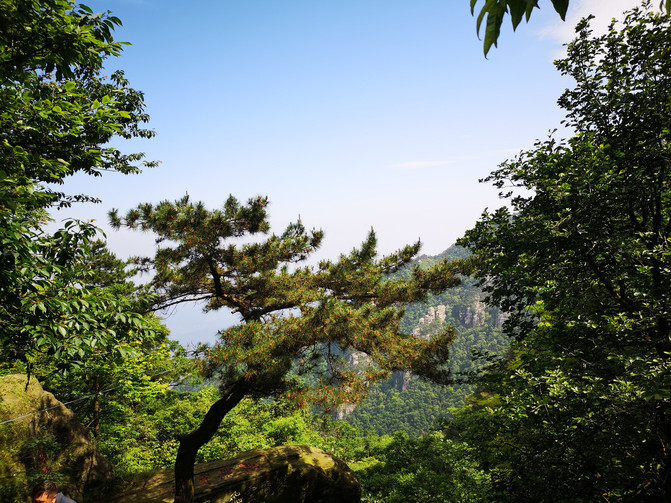
xianrendong
When we arrived at Xianren Cave, we happened to meet Taoist priests holding a peace Dharma meeting to commemorate Lu Dongbin's birthday.

Xianrendong Fa Hui

Xianrendong Fa Hui
After watching the Taoist priests 'cooking meeting in Xianren Cave for a while, I took a bus to the next attraction-Great Tianchi Lake.
Tianchi Temple was originally built here, but now the temple has been abandoned. Only the rectangular pool in front of the original temple remains. The clear water is still flowing and the light is as spiritual as jade.

datianchi

datianchi
Walking down the stone steps from a small iron gate next to the Great Heaven Lake, you can see a cliff stretching thousands of feet into the ground, facing the ravine below, hanging in the air like a green dragon with its head held high and flying outside the sky. This is the famous scenic spot "Dragon Head Cliff". Viewed from the stone pavilion on the left side of the cliff, the Longshou Cliff stands tall and steep, with a stone across it, just like an azure dragon holding its head high. There is a green pine tree on the top of the cliff, and its leaves stretch out to both sides, like the eyes of a dragon. A few pine trees rooted in the gaps in the rocks under the cliff are blowing in the breeze like dragon beards.
Longshou Cliff is a good place to observe clouds and clouds. Whenever heavy fog hits, clouds and clouds rise in the deep ravine canyons, and Longshou Cliff seems to be swimming proudly in the vast sea of clouds. Standing on a rock is like riding clouds and swimming in space; it is also like riding a dragon to explore the sea and playing with the waves. Soon, the dense fog dissipated, the sky was clear and the sun was shining, and the scenery was green. In the distance, the canyons, rivers, fields, and farms were clearly discernible.

Longshou Cliff

Longshou Cliff

Longshou Cliff

Longshou Cliff
Continue down the stone steps from Longshou Cliff and reach the Shimenjian Suspension Bridge in about 40 minutes. Walking through the suspension bridge, you can take the Xinglong Cable Car to the power station dam to the left, and to the right is the Shimen River Scenic Area.

Shimenjian Suspension Bridge
Shimenjian Scenic Area is located at the western foot of Lushan Mountain in Jiujiang City, Jiangxi Province. It is known as the "West Gate of Lushan Mountain." It is named because of the confrontation between Tianchi Mountain and Tiechuan Feng, with a wall standing thousands of feet, like a stone gate, with waterfalls falling inside. Shimen Stream can be said to be a scenic spot composed of strange peaks, strange rocks, flying waterfalls, green ponds, secluded caves and beautiful ravines. It integrates "majestic, dangerous, strange and beautiful" and is a geological change, biological evolution, natural creation, history and culture. It is known as "The Victory of Kuang Lu" and "The Victory of Mountains and Waters", and was known as the "First Scene of Lushan" in ancient times.

Shimenjian Scenic Area

Shimenjian Scenic Area

Shimenjian Scenic Area

Shimenjian Scenic Area

Shimenjian Scenic Area

Shimenjian Scenic Area
Return to the suspension bridge from Shimenjian Scenic Area, take the cableway to the power station dam, and take a sightseeing bus back to Guling Town.

station dam
Since we couldn't see Poyang Lake in Hanqikou yesterday, the sky was clear today. After lunch, we returned to the hotel and decided to go to Hanqikou again to have a rest. As a result, when I arrived there, I found that the sky above Poyang Lake was still full of clouds and dense fog, and the true appearance of Poyang Lake could not be seen. After waiting here for a while, the fog still showed no signs of dispersing, so I decided to leave and drove to Lulin Lake.
Lulin Lake is surrounded by mountains, green pines and cypresses, and beautiful scenery. This was originally a Lulin Valley full of reed grass and wild animals. In 1954, a dam was built here to store water. The dam is 32 meters high, 120 meters long and 12 meters wide. The entire lake area is about 90,000 square meters and holds 1.2 million cubic meters of water. The lake water is clean and clear, as clear as a mirror, and the mountains reflect each other. There are two small pavilions in the center of the lake, which are beautiful and exquisite in appearance, adding luster to the lake. The water stored in Lulin Lake is currently the main water source for residents in Guling Town, Lushan Mountain.

Lulin Lake

Lulin Lake
Walking along the shores of Lulin Lake and admiring the lakes and mountains, I unknowingly arrived at the Lushan Museum.
Lushan Museum is located in the East Valley of Guling, Lushan District, Jiujiang City, Jiangxi Province, on the bank of Lulin Lake and under Jiuqi Peak. This is the place where Mao Zedong once lived during his stay in Lushan. It is called Lulin No. 1 Villa.
The collections in the museum reflect the historical and cultural glory of Lushan Mountain. They include ancient bronzes and ceramics of past dynasties unearthed locally and collected from other places. There are calligraphy and stele inscriptions on Lushan by famous calligraphers in the Tang and Song Dynasties such as Yan Zhenqing, Liu Gongquan, Mi Fu, and Huang Tingjian. There are calligraphy and painting scrolls by famous painters in the Ming and Qing Dynasties such as Tang Yin and Zheng Banqiao. The most precious ones are the "Five Hundred Arhats and Luo Tu", the bloody script "Hua Yan Jing" and crystal Buddha beads, all of which are national first-class cultural relics treasures. The museum also collects porcelain plates with the character "Chiang" used by Chiang Kai-shek, Song Meiling's ivory handle fans, and swords and copper inkstones presented by officials when Chiang Kai-shek was fifty years old. There are also collections of bronzes, pottery, handicrafts, gold and stone seal cuts, coins of past dynasties, etc., many of which are rare treasures.

Lushan Museum

Lushan Museum

Lushan Museum

Lushan Museum
After visiting the Lushan Museum, I took a bus back to Guling Town. I had almost finished visiting the scenic spots on Lushan and decided to go to Tianmu to soak in the hot springs tomorrow. After dinner, I strolled around the street park for a while, returned to the hotel and contacted the driver who had chatted with yesterday, and made an appointment to leave tomorrow and rested.
D15
Arriving on Guling Street again early in the morning, there were clouds and clouds floating in the valley. Guling Street has just woken up, and many local residents on the street are preparing to welcome the arrival of tourists.

Guling Street in the morning

Guling Street in the morning

Guling Street in the morning

Guling Street in the morning
I returned to the hotel and had breakfast early. I heard that the Cloud Observation Pavilion was a good place to watch the clouds of clouds. We lived not far from the Yunguanting Pavilion, so we decided to go there and have a look.
The Yunguanting Pavilion is located behind the Guanyun Villa on the north side of Guling Street. It is the best place to view the sea of clouds. After the rain and the early clearing, the vast sea of clouds surged, and the vast waterfalls poured down with clouds, making it spectacular. In addition to seeing the rare waterfall clouds, the Yunguanting Pavilion is also a good place to watch the sunset in the evening.
It takes less than ten minutes to walk from your residence to Guanyun Villa. Enter from a small door next to Guanyun Villa and walk on a quiet path. Not far away is the Guanyun Pavilion. When we arrived, there was a cloud of clouds moving slowly between the valleys, and the cotton-like cloud was entangled in the mountains. After about ten minutes, the fog drifted past the mountain depression in front of you, and the lush mountains were visible in all directions.

Guanyun Pavilion

Guanyun Pavilion

Guanyun Pavilion
After returning from Guanyun Pavilion, the agreed departure time was up. Starting from Guling Town, it takes an hour to Lushan Tianmu Wenquan Resort.
Lushan Tianmu Wenquan Resort is built on the former site of "Lushan Hot Spring", one of the eight scenic spots in the south of Lushan Mountain. It is a four-star resort integrating hot springs, catering, guest rooms, meetings and entertainment.
It was nearly noon when we arrived at the resort, and we booked a room at Zhongbo Xintang in Tianmu Wenquan Resort. Boxintang is 400 meters away from the hotel lobby. It is a single-family villa located among green trees. After checking in, the hotel housekeeper took us to our room.

Lushan Tianmu Wenquan Resort--Boxintang

Lushan Tianmu Wenquan Resort--Boxintang
The hot spring area does not open until 2 p.m.. After lunch, we were wandering on the street and happened to see a bus heading for Lushan City passing by, so we decided to get on the bus and go to Lushan City first.
Lushan City, formerly known as Xingzi County, is a county-level city under the jurisdiction of Jiujiang City, Jiangxi Province. The urban area faces Poyang Lake, with water transportation extending in all directions. Since ancient times, it has been known as the "throat of the south and the key to the Xijiang River".
We got off at the nearest station to Poyang Lake and walked to Yuanming Square on the shores of Poyang Lake. There is a walking trail built along the bank of Poyang Lake in the square. There is a stone island in the lake called Luoxingdun. You can walk to the stone island from the bank in the dry season. It has rained continuously in the past few days, and the lake water has risen, flooding the road leading to Luoxingdun. I can only stand by the lake and look into the distance.
Luoxing Dun, also known as Luoxing Stone, is also known as Dexing Mountain. It is located in the center of Erli Lake in the south of Ziyang embankment in Lushan City (formerly Xingzi County). It is a landmark building and symbolic cultural relic in Lushan City. It is a small stone island, several feet high, about a hundred steps in length and width, and a total area of only 1800 square meters. It echoes Dagu Mountain (also known as Xieshan) in Hukou County. During the Five Dynasties, Luoxingdun was named Baoshi Mountain. In the early Song Dynasty, pavilions and courtyards were built on it, which were repaired in successive dynasties. In the Ming Dynasty, pavilions and pavilions were built. Due to the vicissitudes of life, few remain today.
Standing on the shore and overlooking the sky, the blue waves are in the sky and the water is in the sky, the beautiful peaks of Lushan Mountain are lightly covered by light smoke, and the Falling Star Dun is shaped like a star floating on the water.

Yuanming Square

poyang Lake

poyang Lake

falling star Pier
It was nearly 4 o'clock when we returned to Tianmu Hot Spring from Lushan City, and we arrived at the hot spring area.
Lushan Hot Spring is located at the southern foot of Lushan Mountain. The spring eye is located in today's Tianmu Wenquan Resort in Lushan Mountain. It is the largest oxygen-rich hot spring in the country. It is rich in more than 20 kinds of minerals and trace elements that are beneficial to the human body such as calcium, magnesium, sulfur, and potassium. It is known as the "No. 1 Hot Spring in Jiangnan".

Lushan Tianmu Hot Spring

Lushan Tianmu Hot Spring

Lushan Tianmu Hot Spring

Lushan Tianmu Hot Spring

Lushan Tianmu Hot Spring
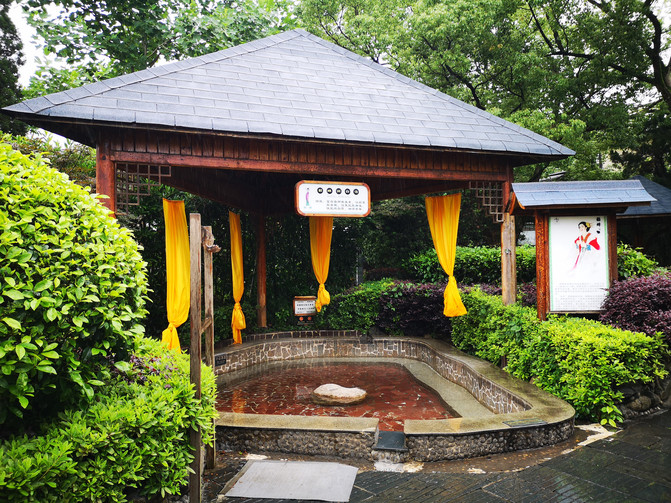
Lushan Tianmu Hot Spring

Lushan Tianmu Hot Spring

Lushan Tianmu Hot Spring
D16
Today, we are going to Xiufeng Scenic Area, the location of the waterfall described in Li Bai's "Looking at Lushan Waterfall". Take the bus from Tianmu Hot Spring to Lushan City and get off at Xiufeng Station. Walk along the road for more than ten minutes to the gate of the scenic spot. Flowers are in full bloom on the roadside, and when you look up, you can see a silver chain-like waterfall hanging among the mountains.
Lushan Xiufeng Scenic Area is located at the southern foot of Lushan Mountain. It is well known for the famous sentence "Looking at Lushan Waterfall" written by the poet immortal Li Bai,"The incense burner grows purple smoke in the sunshine, and the waterfall hangs on the front river from afar." It is known as "The beauty of Lushan Mountain lies in the south of the mountain, and the beauty of the south of the mountain is several beautiful peaks".
Entering the scenic spot, trees on both sides block the sky and the sun, and moss is covered on the stone paths. Walking along the quiet path, the first thing to arrive at is Xiufeng Temple.
Xiufeng Temple is located at the foot of Heming Peak in the south of the mountain. It was originally named Kaixian Temple and is known as one of the "Five Jungles of Lushan Mountain". Li Jing, the ruler of the Southern Tang Dynasty, built a platform and studied here when he was a boy. That is, nine years after the throne (951 AD), he built a temple on the site of Shutai, and named it Kaixian Temple after the omen of the founding of the country. In the forty-sixth year of Kangxi of the Qing Dynasty (1707 AD), Emperor Kangxi visited the south and wrote a plaque "Xiufeng Temple" in calligraphy and gave it to the temple monk Chaoyuan, and later changed its name to Xiufeng Temple.

Xiufeng Temple

Xiufeng Temple
Continue up the Waterfall Road from Xiufeng Temple. You can view the Waterfall and Xianglu Peak from different angles along the way. Although I couldn't see the purple smoke lingering on the top of Xianglu Peak, the exquisite and beautiful mountain peaks with flowing green layers, the waterfalls with silver beads hanging in the sky and flying beads splashing jade fully show the beauty of the beautiful peak.

Xiufeng Scenic Area

Xiufeng Scenic Area

Xiufeng Scenic Area

Xiufeng Scenic Area

Xiufeng Scenic Area

Xiufeng Scenic Area

Xiufeng Scenic Area

Xiufeng Scenic Area
Follow the stone steps up to the top of Xianglu Peak, which is also the end of Xiufeng Cableway. On the left side of the summit, you can reach the Manshu Tower, and on the right side you can reach the source of Lushan Waterfall. We first followed the mountain road shaded by green bamboos to the source of Lushan Waterfall.

Source of Lushan Waterfall

Source of Lushan Waterfall
Returning from the source of Lushan Waterfall and climbing the Manshu Tower viewing platform not far away, you can have a panoramic view of Lushan City and the vast expanse of Poyang Lake. This can make up for the regret of not seeing Poyang Lake on Lushan Mountain.

Manshu Tower View Platform

Manshu Tower View Platform

Manshu Tower View Platform
It was already past 2 o'clock when I returned to Tianmu Hot Spring. I rested in my room for a while and continued to soak in the hot springs in the hot spring area.
D17
Today I am leaving Lushan for Jiuhua Mountain, the holy land of Buddhism. After breakfast in the morning, I took a taxi from Tianmu Hot Spring, arrived at Jiujiang Railway Station in an hour, and boarded the train to Chizhou. It is already 2 o'clock in the afternoon when we arrive at Chizhou Railway Station. To go to Jiuhua Mountain, we have to transfer a bus from Chizhou Railway Station to the Kecun Tourist Service Center located at the foot of Jiuhua Mountain, and then take the sightseeing bus from the scenic area up the mountain. After exiting the station, you can purchase a sightseeing ticket for the scenic spot at the Jiuhuashan Tourist Service Center next to the exit. With the ticket, you can take the free bus from the railway station to Kecun Tourist Service Center. We bought tickets and got on the bus. After a 50-minute drive, we arrived at the Ke Village Tourist Service Center at the foot of Jiuhua Mountain.
Jiuhua Mountain is located in Chizhou, Anhui Province. It is a mountain-type national scenic spot characterized by Buddhist culture and natural and cultural attractions. It is one of the four most famous Buddhist mountains in China. There are many peaks in the territory, surrounded by strange rocks, and the nine main peaks are like nine lotus flowers, in various shapes and each with its charm. The natural sleeping Buddha formed by continuous mountain peaks has become a model of the organic integration of natural landscape and Buddhist culture, and is known as the "Lotus Buddha Country".
"Hell is not empty, and I swear that I will not become a Buddha." Ksitigarbha Bodhisattva is regarded as a representative of filial piety and is known as the Netherworld Master. After Jin Ksitigarbha and Jin Qiaojue passed away, he was found to be uncorrupted and his face looked as if he was alive. He was very similar to the Ksitigarbha Bodhisattva recorded in Buddhist scriptures, so he was regarded by everyone as the avatar of Ksitigarbha Bodhisattva. From then on, Jiuhua Mountain became the Taoist temple of Ksitigarbha Bodhisattva.
The sightseeing ticket for Jiuhuashan is 50 yuan each and is valid for 3 days. There are 5 stations. Each station is limited to one ride. Every time you get on the train from a station, a hole will be made on the ticket to show that you have used the ticket at this station. However, if you go down the mountain from Yingxianqiao Bus Station, regardless of whether you have used the ticket at other stations, the entire ticket will be invalid. For the convenience of traveling, we booked a hotel located on Jiuhua Street. It takes about 30 minutes to drive from the foot of the mountain to Yingxianqiao Bus Station on Jiuhua Street. After checking in from here, we entered the scenic spot.
Jiuhua Street Scenic Area is surrounded by four mountains and has an area of about 4 square kilometers. It is a pearl in the hinterland of Jiuhua. During the Tang Dynasty, Jin Ksitigarbha rebuilt Huacheng Temple, and Jiuhua Street became a prototype; during the Ming and Qing Dynasties, Jiuhua Mountain was extremely popular, and Jiuhua Street with Huacheng Temple as the center took shape. Jiuhua Street Scenic Area is the center of a Buddhist holy land, with concentrated temples and Buddhist activities. It is the best tourist street and town for sightseeing and leisure vacations in the mountains. The main temples on Jiuhua Street include Gion Temple, Huacheng Temple, Centenary Palace, Body Hall, etc.
The hotel we booked is not far from Yingxianqiao Bus Station. After entering the scenic area, we contacted the hotel owner to pick us up at the bus station. It's already 4 o'clock in the check-in. Today, after a day's bus ride and resting in the room for a while, I decided to go shopping on Jiuhua Street first.
There are many temples on Jiuhua Street, and the yellow walls of the temples can be seen everywhere, but the temples are closed at 5 o'clock. After dinner, we strolled around Jiuhua Street and came to a temple. The gate of this temple was very grand. Many tourists gathered in the square in front of the gate. From the square, we can see the golden glazed tiles of the temple hall on the mountain shining in the afterglow of the sun. Shining in the afterglow.

Jiuhua Street

Jiuhua Street

Jiuhua Street

Jiuhua Street

Jiuhua Street
D18
Jiuhua Mountain is divided into Tiantai Scenic Area, Minyuan Scenic Area, Huatai Scenic Area and Jiuhua Street Scenic Area. Today we are going to visit the Tiantai Scenic Area of Jiuhua Mountain.
Tiantai Scenic Area is an alpine tourist area in Jiuhua Mountain. It ends at "Daosheng Cave" in the south, Minyuan Scenic Area in the west, and Huatai Scenic Area in the north. It is surrounded by peaks and rugged rocks, covering an area of about 8 square kilometers. Tiantai Temple is located on the top of Tiantai Temple. It is a long and steep road to Tiantai Temple. There are many strange peaks and rocks along the way, and Buddhist legends are passed down. The main scenic spots include more than 100 places, including Guanyin Stone, Ancient Praying Platform, Dapeng Sutra Listening Stone, Tiantai Temple, Candle Peak, Tiantai Peak, and Shiwang Peak. They can be said to have changed scenery and are colorful. The names of many scenic spots have strong religious color.
Get on the bus from Huxingshan Station opposite the hotel, follow the road to the cableway parking lot in Tiantai Scenic Area, and change to the cableway up the mountain. Walking out of the cableway is not far away from the ancient prayer platform.
The Sutra Prayer Platform is located on the west side of Tiantai Peak. It is a rare platform in the mountains and mountains. It is named because Jin Dizhuang recited scriptures here. It is commonly known as the Ancient Sutra Prayer Platform. This is a platform and a temple. This temple was built in the Qing Dynasty and is also known as Dayuan Nunnery. The whole building is simple and elegant, with coordinated styles, making it the pearl of the Buddhist Kingdom.
Although the ancient prayer platform hall was small, the incense was strong. It is said that Jin Dizang stood on a stone slab on the prayer platform and recited scriptures and lectured Buddha. After six years, a pair of deep footprints were left on this stone slab. The "Footprint Stone" is one of the sacred sites of gold Ksitigarbha. Many pilgrims will take off their shoes when kneeling down.

Gubai Jingtai
Today is Saturday, and many people come to Jiuhua Mountain to worship Buddha. The stone-level road from the Ancient Prayer Platform to Tiantai Temple is crowded with people. After walking for about half an hour, the magnificent Tiantai Temple was in front of you.
Tiantai Temple, also known as "Diztigarang Temple" and "Diztigarang Temple", is located on the top of Tiantai Peak on Jiuhua Mountain, with an altitude of 1306 meters. It is the highest temple on Jiuhua Mountain. On the rock wall in front of the temple, there are cliff stone carvings with huge characters such as "Non-Human". Because Tiantai is a must-visit place for Buddhists to worship the sacred sites of Ksitigarbha, it is called the "Zhongtian World", so Tiantai is often called the main peak of Jiuhua Mountain. There is a saying that "if you don't go to Tiantai, you will come in vain" to Jiuhua.

Tiantai temple

Tiantai temple

Tiantai temple

Tiantai temple
Bypass Tiantai Temple and you will find the main roof of the Tiantai Temple. This is the best place to view the panoramic view of Jiuhua and the sunrise of the sea of clouds."Tiantai Dawn" is one of the ten scenic spots in Jiuhua.

Tiantai Zhengding

Tiantai Zhengding

Tiantai Zhengding

Tiantai Zhengding

Tiantai Zhengding

Shiwangfeng
Return to the ancient prayer platform from the top of the rooftop, follow the stone steps down the mountain, and you will reach Guanyin Peak not far away.
Guanyin Peak, the temple name Yuantong Nunnery, was built because the temple is adjacent to the peak. Over time, the name of the peak replaced the name of the temple. This temple was built on the cliff. The main hall was built on the top of the cliff, and the side hall was built under the cliff, but it was the same height as the main hall. It was actually a three-story hall. There is a strange stone standing on the summit in front of the door, resembling the statue of "Guanyin", so the temple is named "Guanyin Peak". Watching Guanyin Peak on the platform behind the temple is like Guanyin standing on the back of a chelon fish. But he saw Guanyin's eyes looking straight up, her chest slightly bulging, her robe, wide sleeves and a large collar, a hood draped to her shoulders, her left elbow slightly bent, and her robe kept her feet exposed. She floated leisurely among the mountains. Under Guanyin Rock, stone peaks are like pillars and ancient pine trees are beautiful.
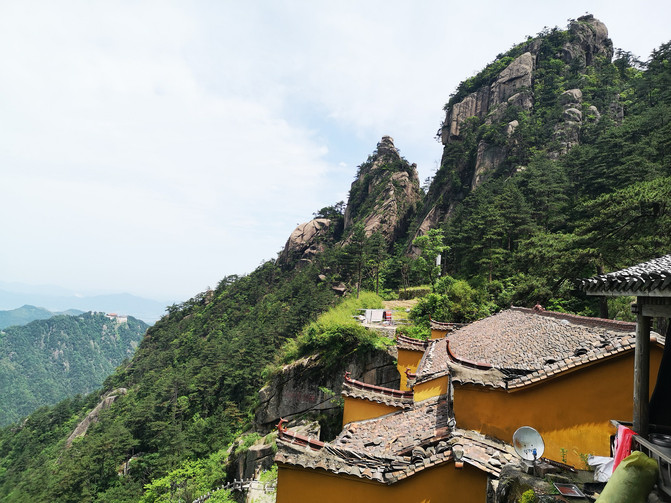
Guanyin peak

Guanyin peak
Continue down the steep stone steps, surrounded by peaks, towering rocks and picturesque scenery, and pass many temples along the way. After crossing the suspension bridge, a dotted courtyard appeared in front of you. This is the Minyuan Scenic Area.
The Minyuanni 'an Group is located between Tiantai Peak and Chaxiao Peak in Jiuhua Mountain. It is divided into Shangmin Garden, Zhongmin Garden and Xiamin Garden. Min Yuan is a quiet place very suitable for practice. It is full of green mountains, green waters, and continuous streams. In addition, it is far away from the hustle and bustle and is free from external interference, which is very conducive to meditation. Therefore, more and more Ninns are built and become a residential group of Ninns. Minyuan has more than 20 nunnery, most of which are buildings in the Ming and Qing Dynasties. It is also the most distinctive nunnery community in China at present. It has a compact layout, distinctive characteristics, equal emphasis on agriculture and Zen, pure Tao and style, unity of man and nature, and harmony with nature. It is an excellent place for sightseeing, experience, leisure and self-cultivation.
Minyuan Nunnery is a representative of the civilian-style temple architecture in southern Anhui on Jiuhua Mountain. Nunnery generally has courtyards with flower houses or vegetable beds, surrounded by green shades, and the environment is quiet. These nunnery have white walls and brown tiles, small external windows, and horse-head walls. They integrate the Buddhist temple and living rooms into one, making life very convenient. In most nuns, there are two nuns, one teacher and one apprentice, who recite scriptures and pay homage to Buddha in the morning and evening, occasionally growing vegetables and picking tea, wholeheartedly protecting Buddha, and living a peaceful life.

Minyuan Nian Group

Minyuan Nian Group

Minyuan Nian Group

Minyuan Nian Group

Minyuan Nian Group

Minyuan Nian Group
Continue down from Minyuan Nian Group to Fenghuang Pine Station and take a bus back to Jiuhua Street.
After lunch, I went back to my place to rest first. At around 2 o'clock in the afternoon, we set out for the Centenary Palace, where the body of the Wuxia monk, known as Centenary Duke, is enshrined.
There are two options to reach Centenary Palace from Jiuhua Street. You can take the Centenary Palace ground sightseeing cable car on Jiuhua Street, or you can reach it on foot from Gion Temple. We chose to take the cable car up the mountain, visit the Centenary Palace and walk down the mountain.
Baisui Palace is located on the top of Chaxiao Peak at an altitude of 871 meters on Jiuhua Mountain. It was originally named Zhaixing Temple, also known as Wannian Temple. It was built in the Ming Dynasty and is a national key temple. Centenary Palace, Gion Temple, Dongya Zen Temple, and Ganlu Temple are called the "Four Great Jungles" of Jiuhua Mountain. During the Wanli period, monk Wuxia stabbed his tongue and blood gold powder in Jiuhua Mountain. It took him more than 20 years to copy eighty-one volumes of the "Dafang Guangfo Huayan Sutra". Monk Wuxia passed away at the age of 126 and his body did not rot for three years. His disciples then sacrificed his body in gold and reported to the court.
When you walk out of the Centenary Palace Cable Car, you must see the magical craftsmanship of nature, which is the natural reclining Buddha that looks like a mountain and a Buddha when viewed horizontally.

Natural reclining Buddha

Natural reclining Buddha

Baisui Palace

Baisui Palace
Walking down the stone steps from Centenary Palace, you will reach Gion Zen Temple in less than an hour.
Gion Temple, built next to the mountain, is the first temple in front of Jiuhua Street. It was built in the Ming Dynasty. During the Kangxi period of the Qing Dynasty, it was one of the east buildings of Huacheng Temple, and became the ten-sided jungle during the Jiaqing period of the Qing Dynasty. It was destroyed during the Xianfeng period and later rebuilt. The temple is very large in scale, and the layered palace-style buildings are like royal palaces in ancient times.

Gion Temple

Gion Temple

Gion Temple

Gion Temple
It was already 5 o'clock when I left Gion Zen Temple. I felt a little tired after walking on the mountain all day, so I went back to my residence early to rest.
D19
You need to go down the mountain from Jiuhua Street to Huatai Scenic Area. Tickets for Jiuhua Mountain are valid for 3 days. However, if you return to the mountain after going down the mountain, you need to go through the procedures for entering the mountain again at Yingxianqiao Bus Station. Go through the procedures for entering the mountain twice in the morning and take a bus to Huatai Scenic Area.
Huatai Scenic Area is located north of Tiantai Peak. It consists of Dahuatai and Xiaohuatai. It is one of the core scenic spots in Jiuhua Mountain. The scenery in the scenic area is magnificent and beautiful. It is famous for its strange peaks and rocks, clouds of clouds and rime, and the sea of flowers. It is known as the saying that "Lingshan Jiuhua, the beauty lies in the flower platform." The surrounding area is surrounded by ravines and numerous peaks. In the scenic area, the peaks and ridges are abrupt, the rocks are jagged, the valley caves are deep, and the weather is myriad. The peculiar geological landform magically constitutes the most famous wonder of the "natural sleeping Buddha" in Jiuhua Mountain; the top of the Huatai is the highest peak in the scenic area, with abundant mountain flowers and lush Jiamu. Climb to the top of the flower platform and have a panoramic view of Jiuhua. You can also "get close to the sleeping Buddha and listen to the Buddha's sound". You can have zero-distance contact with the magical "sleeping Buddha". You can be protected by the Buddha and feel more spiritual.
Take the cableway up the mountain and walk along the high-altitude plank road. The spirit stones around you are clever, like people imitating objects, and are lifelike; the dragons and pines are winding, and the mountain flowers are romantic, competing for surprises.

Huatai Scenic Area

Huatai Scenic Area

Huatai Scenic Area

Huatai Scenic Area

Huatai Scenic Area

Huatai Scenic Area
At the end of the plank road is a fork in the road. The road on one side leads to Dahuatai. You can detour to reach the cableway station, forming a sightseeing loop. The road on one side leads to Xiaohuatai. It takes more than 3 hours to reach the Tiantai Scenic Area. However, if you don't go to the Tiantai Scenic Area, you need to return the same way after arriving at Xiaohuatai. After a moment of hesitation, he decided to give up Xiaohuatai, so he stepped on the stone steps to the Dahuatai.
Dahuatai, formerly known as Zhongfeng, is located in the northeast of Tiantai Peak and on the north side of Huixian Peak (Xiaohuatai). It is 1291 meters above sea level. It is surrounded by peaks and sits alone among them. It is the best point for tourists to explore the mountains. There is a large area of Rhododendron Wharf between the Zhongfeng and Jinxianfeng. In the blooming season, the fragrance of orchids wafts and the mountains reflects the red everywhere. Therefore, the two peaks are named Da and Xiaohuatai. Climbing the peak and looking around, you will find that more than ten peaks, including Huixian, Fuzi, Tianmen, stalagmite, Shami, Dagu, and Tianzhu, are all unique and beautiful.

Dahuatai

Dahuatai

Dahuatai

Dahuatai

Dahuatai

Dahuatai

Dahuatai
Returning from Dahuatai, I took the Huatai Scenic Area cableway down the mountain, purchased a new sightseeing ticket and returned to Jiuhua Street. After lunch, take a bus from Huxingshan Station and get off at the Body Hall. Go up the stone steps and arrive at the Body Hall in more than ten minutes.
Jiuhua Mountain has three flesh-body halls, in Shenguang Ridge, Baisui Palace and Shuangxi Temple. The Shenguangling Body Hall is the place where the body of Jin Ksitigarbha and Jin Qiao Jue is buried. It is also known as the "Ksitigarbha Pagoda", commonly known as the "Laoye Ding", and also known as the Moon Body Hall. It was built during the Zhenyuan period of the Tang Dynasty and covers an area of 705 square meters.
In his later years, Jin Ksitigarbha used this to read the scriptures for Nantai. Three years after his death, he still had a face like a living. This was a sign that the Bodhisattva had come to the world to respond to his transformation, and he was determined to be the Bodhisattva Ksitigarbha. So a three-story stone tower was built here to bury his body, known as the Body Tower, also known as the Ksitigarbha Tomb. During the Wanli period of the Ming Dynasty, the court awarded silver to rebuild the pagoda hall and a "Pagoda for Protecting the Body of the Country." In the twelfth year of Guangxu (1886 AD), the flesh-body tower was rebuilt on a large scale. The door of the temple was moved to the south, and the horizontal plaque of "The First Mountain in the Southeast" was hung on the top of the door. From then on, Jiuhua Mountain became famous and gradually formed the Yinghua Taoist Temple of Ksitigarbha Bodhisattva, which is also known as Manjusri on Mount Wutai, Samannah on Mount Emei, and Guanyin on Mount Putuo.

Body Palace

Body Palace

Body Palace

Body Palace
Go down the mountain along the stone steps next to the Body Hall, and pass through temples such as Shangchan Hall and Jingjie Jingshe.
Shangchan Hall, formerly known as "Jingdetang", is located halfway up the ridge of Shenguang Lingnan. It was built in the Ming Dynasty and rebuilt by Zong Yan, a disciple of Yulin State Teacher in the sixth year of Kangxi of the Qing Dynasty (1667 AD). It changed its name to its present name. In 1928, the abbot, Monk Zhifang, rebuilt the main hall and received people in peace. It became one of the seven jungles of Jiuhua Mountain, including Centenary Palace, Dongya Zen Temple, Gion Temple, Ganlu Temple, Lianhua Temple, and Leshan Temple. In 1957, due to an accidental fire by monks, Guanyin Hall was partially destroyed in the fire. It was renovated in 1987, with a building area of 1280 square meters, and was identified by the State Council as a national key Buddhist temple in Han nationality areas.

Shangchantang

Shangchantang
Jingjie Jingshe is located on the west of Jiuhua Street, the southeast foot of Shenguang Ridge, and the north side of Guangji Maopeng. The site was originally named Ancient Baizi Hall. The date of construction is unknown. In 1985, bhishuni Chang Jie raised funds to rebuild the temple at the old temple foundation and renamed it "Jingjie Jingshe".

Jingjie Jingshe
Come down from the mountain road and return to Jiuhua Street, next to it is the Wutan Zen Forest.
Wutan Forest is a large-scale temple built in the late 19th century. It is also known as the "Wutan Zen Forest" and is one of the 72 houses of Huacheng Temple. It was built during the Kangxi period of the Qing Dynasty. The temple survived during the Daoguang period of the Qing Dynasty and was destroyed by soldiers during the Xianfeng period. In the twelfth year of Guangxu (1886 AD), Dingchan monks were recruited and rebuilt. It is said that when it was first built, monks cut down the ancient tree on the pipa-shaped hill behind the temple. It was seen that its wood was hard, its veins were slender, and it was cool and fragrant. It was called a Buddhist treasure-the sandalwood tree. It is said that the pipa-shaped hill is similar to the Niutou Mountain in South India (famous for its abundant abundance of sandalwood trees) described in Buddhist scriptures, because the temple is named "sandalwood forest". The arch and window lattice in the temple are engraved with Tang Monk's scriptures and Buddhist and mythological stories, which are exquisite and vivid. The main building has a two-story Buddha Hall at the gate. The upper floor is the Maitreya Hall, and the rear hall is the Weituo Hall.

Yuantan Zen Forest

Yuantan Zen Forest

Yuantan Zen Forest

Yuantan Zen Forest
After coming out of Yuantan Zen Forest, I came to Huacheng Temple.
Huacheng Temple is the first ancestral temple of Jiuhua Mountain, with the longest history. It is also the Taoist temple of Ksitigarbha Bodhisattva and the "general jungle" of Jiuhua Mountain. It was built in the Tang Dynasty. In the early years of Zhide (756 AD), the local gentry invited Jin Qiaojue, a monk from Silla, to live there. After Jin Qiaojue passed away at the age of 99 in the tenth year of Zhenyuan (794 AD), the monks regarded it as the embodiment of Ksitigarbha Bodhisattva, and Huacheng Temple was then turned into the Taoist Temple of Ksitigarbha King.
Huacheng Temple is the only temple on Jiuhua Mountain that faces north to south, is symmetrically arranged on the axis, and gradually rises from south to north. It is divided into four front and back, and is built against the mountain. The building is solemn, simple, and magnificent. Today, Huacheng Temple has been built into the Jiuhuashan Historical and Cultural Relics Museum, collecting and displaying more than 1,000 pieces of various scriptures, Buddhist utensils, imperial edicts, jade seals, and calligraphy and paintings, many of which are rare treasures.

Huacheng Temple
It was already past 4 o'clock after visiting Huacheng Temple, and I suddenly remembered the magnificent mountain gate I saw the evening before yesterday. The temple had not yet been there, so I hurried to the temple. Fortunately, I entered the temple before the temple closed. It turned out that this temple is Jiuhua Kiztigartigardi Temple.
Jiuhua Tibetan Temple was built in the Longxing period of the Southern Song Dynasty and has a history of more than 800 years. The temple now has an old-fashioned hall with three dark and five dark buildings, with a statue of King Ksitigarbha Bodhisattva in it; there are ten halls of Ten Kings, with ten halls of King of Hell sculpted in the hall. Civil and military judges, yaksha and ghosts are in a variety of shapes and lifelike shapes.

Jiuhua Tibetan Temple

Jiuhua Tibetan Temple

Jiuhua Tibetan Temple
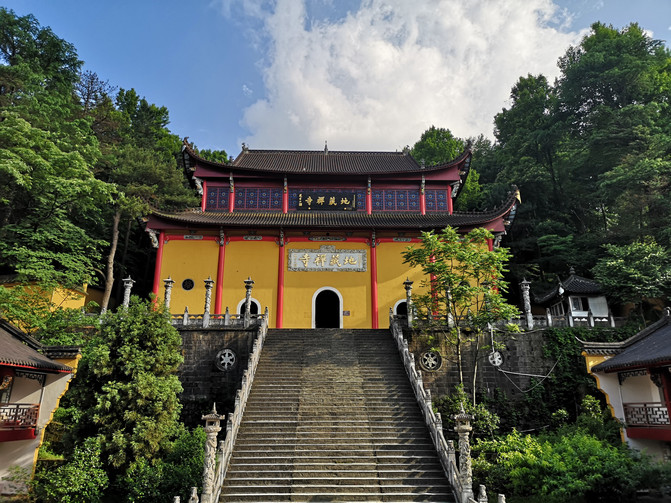
Jiuhua Tibetan Temple

Jiuhua Tibetan Temple
There were stone steps next to the main hall leading to the mountain. I met several tourists who came down from the top and learned that there was a main hall above, so I quickly walked up. When I got up, I found that I had returned to the Body Palace again. At this time, there were not many tourists here. When we asked the staff, we learned that the door we entered by car from the side of the road was the west gate, the one next to the Yutan Zen Forest was the east gate, and the one we had just entered was the north gate, which is the main entrance of the Body Palace.
After coming out of Jiuhua Tibetan Temple, I met a restaurant that runs vegetarian houses on Jiuhua Street. After eating vegetarian food, the trip was almost over. I bought some local specialties on Jiuhua Street and returned to my residence.

Jiuhua Street Suzhai
D20
After breakfast in the morning, take a bus down the mountain from Yingxianqiao Bus Station, transfer to a bus to Chizhou Railway Station for Nanjing. For convenient transportation tomorrow, we chose a hotel near Nanjing South Railway Station.
This time, I was just a transit through Nanjing, so I only walked around the city of Nanjing. Nanjing Confucius Temple Qinhuai scenery belt is rich in history and culture. Confucius Temple snacks rank first among the four major snacks in China. Use the afternoon to visit the Qinhuai River in Confucius Temple.
Nanjing Confucius Temple Qinhuai Scenic Belt is located in Qinhuai District, Nanjing, Jiangsu Province. With Confucius Temple as the core, the ten-mile Qinhuai as the axis, and the Ming City Wall as the link, it takes Confucianism, imperial examination culture, folk culture, etc. as the connotation, and integrates tourism, food shopping, popular science education, festival culture and other functions. It is a gathering place for Nanjing's history and culture.
Take the subway to Confucius Temple and come to Zhanyuan first.
Zhanyuan is located in the core area of the Qinhuai Scenic Belt of Confucius Temple, Qinhuai District, Nanjing City, Jiangsu Province. It has a history of more than 600 years. It is the most well-preserved classical garden complex of the Ming Dynasty in Nanjing. It is one of the four famous gardens in the south of the Yangtze River and the only open palace of the Ming Dynasty. It was once the garden of Xu Da, the founding hero of the Ming Dynasty. It was the office place of various Jiangnan governors in the Qing Dynasty. During the Taiping Rebellion, it was the residence of the Eastern King Yang Xiuqing. Zhanyuan is famous for its rockery. It is named after Ouyang Xiu's poem "Looking at the Jade Hall as in the Sky". In the Ming Dynasty, it was called the "No. 1 Garden in Nandu". Zhanyuan houses the Taiping Heavenly Kingdom History Museum, which is the only Taiping Heavenly Kingdom history museum in China.
Today is Monday, just in time for Zhanyuan to be closed during the day and will not be open to the public until 5 p.m., so we had to go to the Confucius Temple by the Qinhuai River first.
The Qinhuai River is the cradle of Nanjing's ancient civilization and Nanjing's mother river. It is very famous in history. This place has always been "the smoky and moonlit area of the Six Dynasties, where gold powder gathered", and it is also a prosperous place for ten generations."The clothes and cultural relics are flourishing in the south of the Yangtze River; the literary talent is romantic and the best in the sea." It is known as "China's first historical and cultural famous river".

Qinhuai River

Qinhuai River
Nanjing Confucius Temple, namely Nanjing Confucius Temple and Nanjing Confucian Temple, is located on Gongyuan Street on the north bank of the Qinhuai River in Qinhuai District, Nanjing, Jiangsu Province, west of Jiangnan Gongyuan. It is a place where Confucius is worshipped and sacrificed. It is one of the four major Confucian temples in China. It is the hub of ancient Jiangnan culture in China and a place where Jinling's historical culture gathers. Confucius Temple is a large-scale ancient building complex. It mainly consists of three major building complexes: Confucius Temple, Xuegong Palace and Gongyuan, and covers a huge area.

Nanjing Confucius Temple

Nanjing Confucius Temple

Nanjing Confucius Temple
Nanjing Confucius Temple was not only the cultural and educational center of Nanjing during the Ming and Qing Dynasties, but also the cultural and educational building complex ranked first among the southeastern provinces. It was the largest traditional ancient market in China. It was the four major downtown areas in China, together with Shanghai City God Temple, Suzhou Xuanmiao Temple and Beijing Tianqiao.

Nanjing Confucius Temple

Nanjing Confucius Temple

Nanjing Confucius Temple

Nanjing Confucius Temple
After visiting the Confucius Temple and tasting delicious snacks, we returned to Zhanyuan.
Entering Zhanyuan, what you see in front of you are the quiet and elegant towers, steep rockery, the sudden and beautiful Taihu Lake stones and the magnificent ancient buildings of the Ming and Qing Dynasties. Although Zhanyuan is located in a busy city, the layout of the pavilions is elegant and exquisite, with mountains and rocks and peaks, and the water is winding. It is a garden that takes tranquility in the busy city.

zhanyuan

zhanyuan

zhanyuan

zhanyuan

zhanyuan

zhanyuan

zhanyuan

zhanyuan

zhanyuan

zhanyuan
It was already dark after coming out of Zhanyuan. We returned to the Qinhuai River to enjoy the beautiful night view of Qinhuai River.

Night view of Qinhuai River

Night view of Qinhuai River

Night view of Qinhuai River
After admiring the night view of Qinhuai, and strolling around the street, I accidentally saw Liu Yuxi of the Tang Dynasty's "wild grass and flowers beside the Suzaku Bridge, and the sunset at the entrance of Wuyi Lane." In the old days, Wang Xie Tang and Yan flew into the homes of ordinary people." Wuyi Lane described in.
Nanjing Wuyi Alley is on the south bank of Wende Bridge. It is a quiet and narrow alley. It was the residence of the Imperial Army during the Three Kingdoms Period of Dongwu. Because the Imperial Army was wearing black military uniforms at that time, it was commonly known as Wuyi Lane. During the Eastern Jin Dynasty, Wang Dao and Xie An lived in Wuyi Lane, and people called their children "Wuyi Lang".

Nanjing Confucius Temple

Nanjing Confucius Temple

Nanjing Confucius Temple
D21
I will be returning to Tianjin today. The train leaves after 4 o'clock in the afternoon today. I will use the morning time to visit the Nanjing Presidential Palace. Check out first, store your luggage at the hotel, and then drive to the Presidential Palace.
The Nanjing Presidential Palace is located at No. 292 Changjiang Road, Xuanwu District, Nanjing City, Jiangsu Province. Its history can be traced back to the Marquis Guidde Mansion and the King Mansion of the Han Dynasty in the early Ming Dynasty. In the Qing Dynasty, it was designated as Jiangning Weaving Office and Liangjiang Governor Office. It was used as a palace for the Southern Tour of Emperor Qianlong of the Qing Dynasty. After the Taiping Rebellion established its capital in Tianjing (present-day Nanjing), it was expanded into Tianwang Mansion on this basis. On January 1, 1912, Sun Yat-sen was sworn in as the Provisional President of the Republic of China here, which became the Presidential Office, and later the Presidential Office of the Nanjing National Government.
The Nanjing Presidential Palace has both ancient Chinese traditional Jiangnan gardens and modern architectural relics from the western wind spreading eastward. Since modern times, it has many times become the center of China's political and military affairs and the source of major events. A series of major events in China have occurred here or are closely related to this place. Some important figures have been active here. It is the main representative of Nanjing's Republic of China architecture., an important site in modern Chinese history, has now been opened as the Museum of Modern Chinese History.

Nanjing presidential palace

Nanjing presidential palace

Nanjing presidential palace

Nanjing presidential palace

Nanjing presidential palace

Nanjing presidential palace

Nanjing presidential palace
The Nanjing Presidential Palace was bigger than I thought, and I walked around it for nearly 3 hours. After coming out of the Presidential Palace, I saw that there was still some time before the train left, so I took a taxi to the Dabaoen Temple Ruins Park.
The Dabaoen Temple Ruins Park is located outside Zhonghua Gate, Qinhuai District, Nanjing, Jiangsu Province. It is the highest-specification, largest and most completely preserved temple site in China. The ruins park protectively displays the thousand-year-old underground palace and precious galleries in the Dabaoen Temple site, as well as world-class national treasures such as stone letters, iron letters, Qibao Ayu Pagoda, and gold coffin and silver coffin unearthed from the underground palace of Qinhuai. It is an important part of the Confucius Temple scenery belt.
The entire ruins park covers an area of about 140000 square meters, including the ruins protection area, the Dabaoen Temple Ruins Museum, the Dabaoen Tower, etc. Walking through the mountain gate, you will cross the Xiangshui River, Xiangshui River Bridge Ruins, and Imperial Road Ruins. Entering the main foyer, you can see the Da Bao 'en Tower when you look up, and you can see the ruins of the Tianwang Hall of the ancient Da Bao' en Temple.
The high-profile glazed pagoda in the ruins park was not rebuilt as it was in history. Instead, it was reproduced in the form of a light steel-frame glass protection tower, giving it symbolic meaning and connotation on the premise of completely protecting the ruins, leaving it to everyone. Infinite imagination of this lost grand scene.

Dabaoen Temple Heritage Park

Dabaoen Temple Heritage Park

Dabaoen Temple Heritage Park

Dabaoen Temple Heritage Park

Dabaoen Temple Heritage Park

Dabaoen Temple Heritage Park-Dabaoen Tower
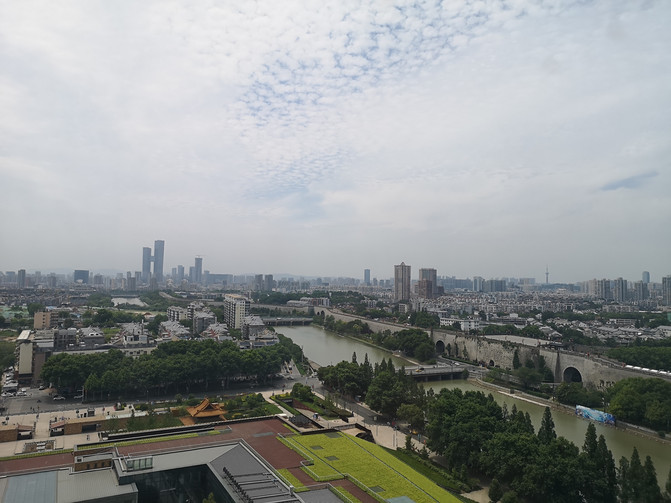
Dabaoen Temple Heritage Park
After visiting the Dabaoen Temple Ruins Park, I took the subway back to my residence. After picking up my luggage, I went to Nanjing South Railway Station and successfully boarded the train back to Tianjin.
June 2021
Previous Article:Chishan Lake in my eyes and Longtan Railway Station in my memory
